BERDAN, WILLIAM (1841-1900). Private, 9th New York Infantry, Company F. A native New Yorker, he enlisted there on April 23, 1861, as a private. On May 4, he mustered into the 9th New York Infantry where he served until he mustered out at New York City on May 20, 1863. He applied for a pension in 1898, application 1,204,374. His last residence was on Trenton Avenue in Paterson. He died from a pistol shot in Paterson, New Jersey. His widow, Susanna A. Berdan, applied for and was granted a pension in 1904, certificate 596,430. Section 52, lot 9286.
Civil War Bio Search

BERGEN, ADRIAN VANDEMEER (1841-1893). Major by brevet; first lieutenant, 139th New York Infantry, Companies G and D; private, 3rd Regiment, New York State Militia, Company B. Born in Flatbush, Brooklyn, and employed as a clerk, he first served for three months in the 3rd Regiment in 1861. He re-enlisted as a second lieutenant at Brooklyn on September 9, 1862, and mustered into Company G that day. Bergen was promoted to first lieutenant on October 18, 1863, effective upon his transfer to Company D, and was discharged for disability on August 24, 1864. His regiment participated at numerous engagements in Virginia including: Williamsburg, Baltimore Cross Roads, Charles City Court House, Drewry’s Bluff, and Cold Harbor. At some point, he served as assistant provost marshal at Hampton and Fortress Monroe in Virginia. He was brevetted to major on October 24, 1868, “for gallant and meritorious services.”
Bergen is listed as a clerk in the 1870-1873 and 1873-1876 Brooklyn Directories and as an inspector in the 1880-1882 Brooklyn Directory. His last residence was on Sixth Avenue in Brooklyn. He and his siblings, Cornelius (see), Robert (see), and Rebecca (see), share a family gravestone that is inscribed with their service histories. Section 79, lot 813.
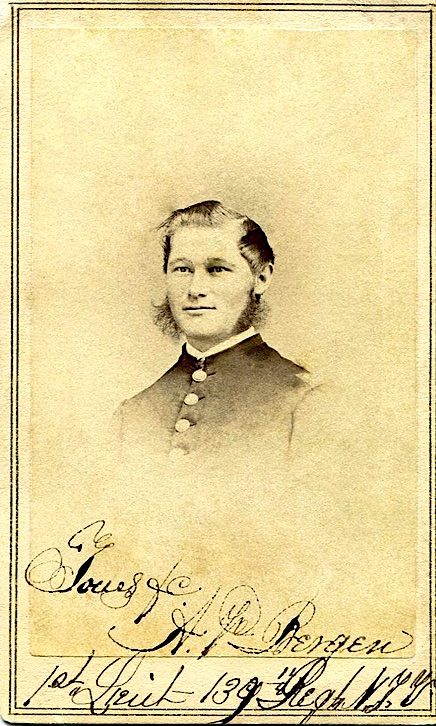

BERGEN, CORNELIUS JOHANNES (1834-1873). Captain, 56th Regiment, New York State National Guard, Company C; first sergeant, 13th Regiment, New York State National Guard, Company H. In 1862, he enlisted at Brooklyn on May 28, mustered into the 13th Regiment (Heavy Artillery) as a first sergeant that day, and mustered out at Brooklyn on September 12. He re-enlisted at Brooklyn as a captain on July 11, 1864, was commissioned into the 56th Regiment’s National Guard on August 2, and mustered out on November 6 of that year at New York City.
Bergen was listed as a printer in the 1865 Brooklyn Directory; he then lived at 67 Willoughby Street. According to the Brooklyn Directory for 1868, he dealt in fancy goods at 207 Fulton Avenue; he still lived at 67 Willoughby Street. Adrian (see) and Robert (see), his brothers, served in the War as did his sister, Rebecca (see). His last home in Brooklyn was at 87 Willoughby Street. Bergen died from tuberculosis. Section 79, lot 813.
BERGEN, JOHN G. (1814-1867). Metropolitan Police Commissioner during the New York City Draft Riots. A Brooklyn native, he was a member of the New York State Assembly in 1854 and later was an active supporter of the Republican Party. When the Metropolitan Police Department was established in 1860, Governor Edwin D. Morgan appointed him to the Board of Police Commissions, of which he was elected treasurer. At that same time, Thomas Coxon Acton was also appointed police commissioner and John Kennedy assumed the position of superintendent. Bergen is listed as police commissioner in the Brooklyn Directories from 1862-1864.
During the July 1863 New York City Draft Riots, Superintendent Kennedy was severely injured by the mob during an inspection tour on July 14, 1863, necessitating that Bergen and Acton assume command. Bergen oversaw the police in Staten Island and Brooklyn while Acton took control of police and military forces in Manhattan. According to The Metropolitan Police, Their Services During Riot Week, Their Honorable Record by David M. Barnes (1863), “He was almost constantly at headquarters during the period of tremor and excitement, and exhibited, to a marked degree, his peculiarities of coolness, prompt conclusions, and steady perseverance.”
Bergen remained in his position until his death and was praised as “always prompt, indefatigable and conscientious in the performance of his duties.” Upon Bergen’s death, Kennedy ordered that flags at all precincts be lowered to half-staff until his burial. His funeral was one of the largest gatherings of police personnel at that time. One of his brothers, Peter Bergen, was a judge; another brother, Teunis Bergen, was a U.S. Congressman. In addition, Bergen was one of the founders of the Union League Club. He last lived at 38th Street near Third Avenue in Brooklyn. His death was attributed to stomach problems. Section 43, lot 267.
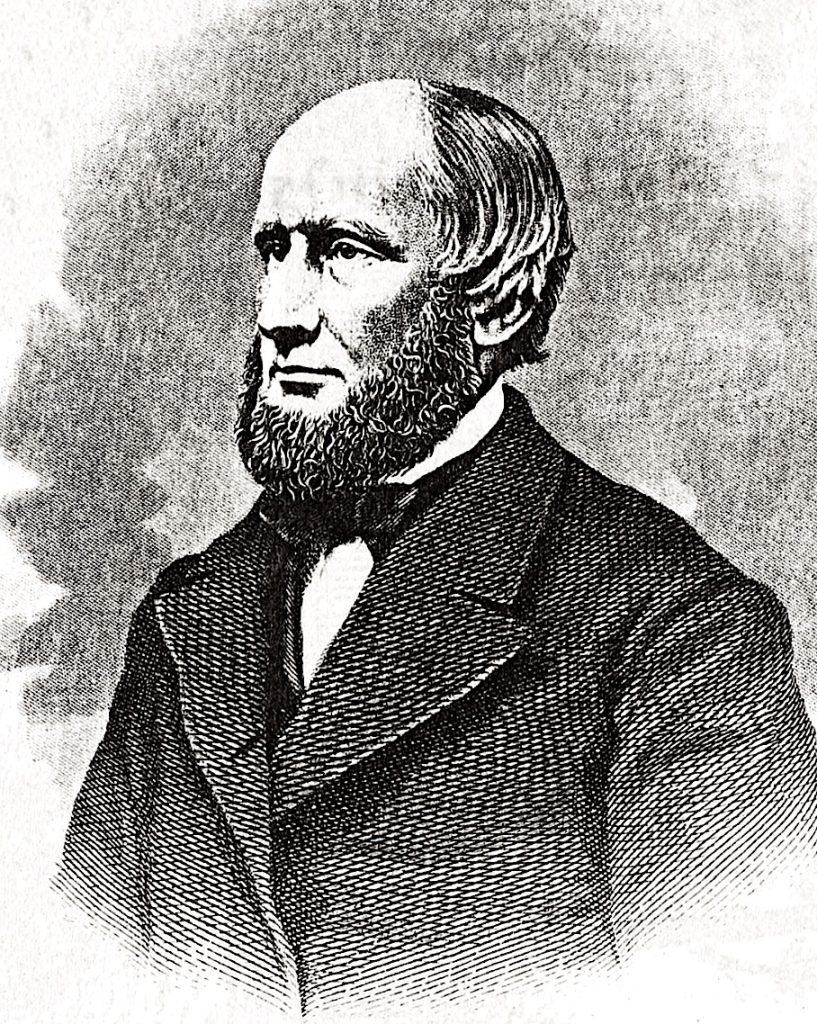

BERGEN, REBECCA T. (1824-1893). Volunteer nurse, Union Army. Bergen’s family headstone lists Rebecca Bergen as serving as a volunteer nurse in 1861. Other siblings who served in the Civil War include Adrian (see), Cornelius (see), and Robert (see). She ministered to the needs of soldiers at a hospital in Georgetown in Washington, D.C.
An anecdote about her life recounts her introduction to President Abraham Lincoln who upon hearing her name said, “Why I have a plow called the Bergen Self-Sharpening Plow; it is the best plow that I have ever used or have ever seen! Do you know that gentleman? He was a Long Islander.” He was delighted to learn that the Bergen in question was Rebecca’s father. Bergen belonged to the Women’s Relief Corps, an arm of the Rankin Post #10 of the G.A.R. She last lived at 73 Sixth Avenue in Brooklyn. On March 5, 1893, she fractured her hip after slipping on the ice and died eight days later. Section 79, lot 813.
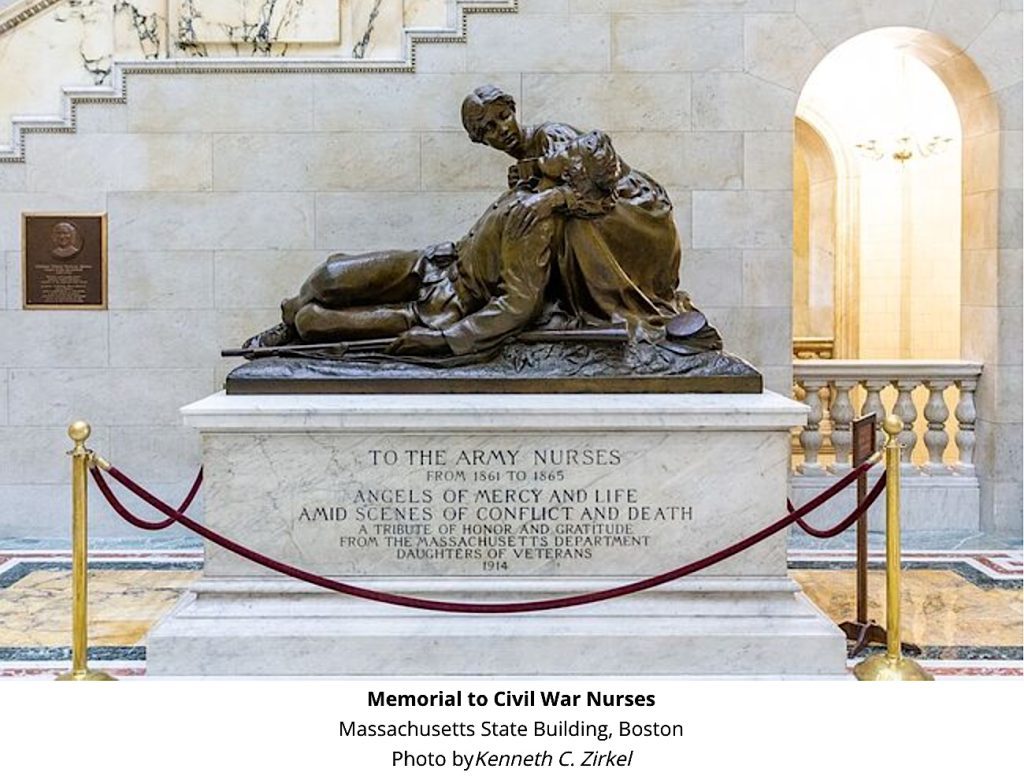

BERGEN, ROBERT G. (1832-1870). Sailor, United States Navy. Bergen was a sailor in the Navy during the Civil War. According to the inscription on the family gravestone, he served aboard the USS Vanderbilt from 1862-64. His brothers, Adrian (see) and Cornelius (see), and sister, Rebecca (see), also served in the War. His last residence was at 67 Willoughby Street in Brooklyn. He died from tuberculosis. Section 79, lot 813.
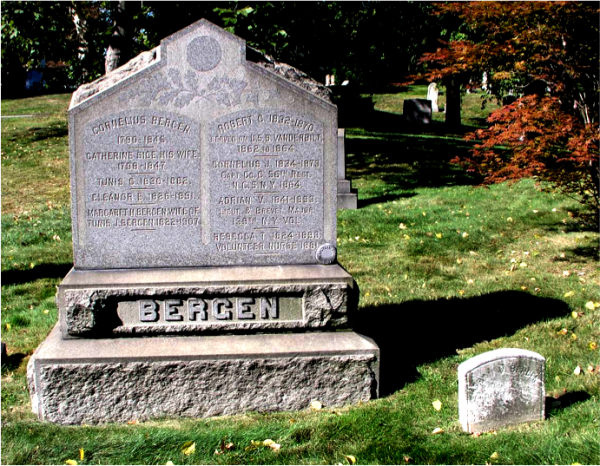
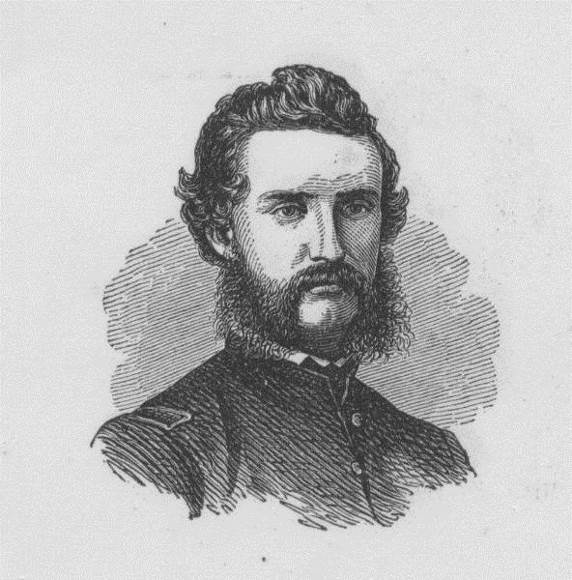
BERGEN, VAN BRUNT MAGAW (1839-1865). First lieutenant and adjutant, 131st New York Infantry, Company E; corporal, 13th Regiment, New York State National Guard, Company G. A Brooklyn native and an engraver by trade, his maternal grandfather (Colonel Van Brunt Magaw) and great-grandfather (Robert Magaw) served in the Revolutionary War. Bergen enlisted at Brooklyn as a corporal on May 28, 1862, mustered into Company G of the 13th Regiment, and mustered out at Brooklyn after three months on September 12. He re-enlisted at New York City on August 28, 1862, and was commissioned into the 131st New York as a first lieutenant on September 6, 1862. Initially, the 131st was sent to Annapolis, Maryland, where they guarded 10,000 Confederate prisoners.
In December of 1862, the regiment became engaged in the battles of the Louisiana Campaign including: Baton Rouge, Donaldsonville, Brashear City, on the Teche, Franklin, Vermillion Bayou, Alexandria, on the Red River and Port Hudson. At Brashear City, Bergen was an assistant quartermaster and assistant inspector general of the La Fourche District. From there, he was sent as an ordnance officer to the Shenandoah Valley under Sheridan’s command. He was promoted to adjutant of his regiment on March 6, 1864. After contracting a cold that eventually settled in his lungs, Bergen returned home to restore his health in December 1864, was discharged for disability on March 10, 1865. He ultimately died of consumption on June 8, 1865, at his residence on Third Avenue and 18th Street in Brooklyn. Section 43, lot 272.
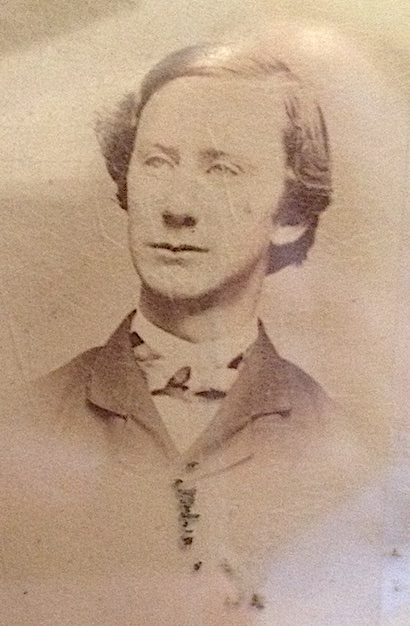
BERGEN, WILLIAM H. (1839-1862). Private, 69th Regiment, New York State National Guard, Company B. After Bergen enlisted as a private at New York City on May 26, 1862, he mustered into the 69th Regiment, and mustered out three months later on September 3 at New York City. He died two weeks later on September 18. Interment at Green-Wood was on September 13, 1868. Section 43, lot 267.
BERGER, ANTHONY (or ANTONE) (1825-1906). Corporal, 132nd New York Infantry, Company H. Born in Germany, Berger enlisted at New York City as a corporal on July 26, 1862. The following October 4, he mustered into the 132nd New York and mustered out at Salisbury, North Carolina, on June 29, 1865. He is listed as a locksmith in the 1875-1876 and 1876-1878 New York City Directories; he then lived on West 26th Street. His last residence was 542 Greene Avenue in Brooklyn where his death was caused by senility. Section 165, lot 27767, grave 2.
BERGH, SAMUEL N. (1831-1869). Regiment commissary, 13th Regiment, New York State National Guard, Company H. He enlisted as a private at Brooklyn on May 28, 1862. On that same day, he was commissioned into Company H and detailed as regiment commissary. He mustered out at Brooklyn on September 12, 1862. His last residence was in Rhode Island. Bergh died from heart disease. Section 45, lot 3996.
BERGMANN, AUGUST (1820-1897). Private, 15th New York Heavy Artillery, Companies M and A. Bergmann, who was born in Germany, enlisted as a private at New York City on December 17, 1863, and mustered into Company M of the 15th New York Heavy Artillery the same day. Sometime during his military service he was transferred within his regiment to Company A. On March 27, 1864, he was listed as absent due to sickness. Other details of his military record are not known. His last residence was on West 17th Street in Manhattan. Section B, lot 11005.
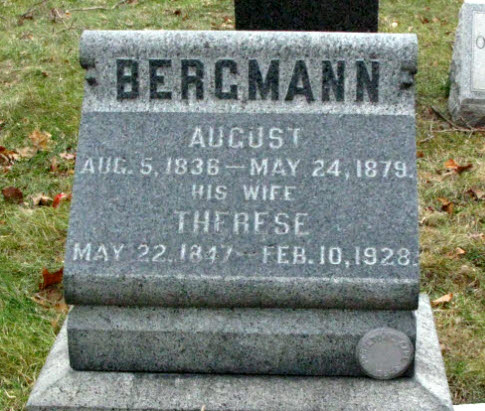
BERGMANN, AUGUST (1836-1879). Corporal, 7th Regiment, New York State National Guard, Company H. Although a gravestone memorializes him and his widow is buried there, no cemetery records indicate his presence at Green-Wood. He enlisted at New York City as a corporal on May 25, 1862, mustered into Company H of the 7th Regiment, and was discharged after serving for three months on September 5 at New York City. Therese Bergmann applied for a widow’s pension from Germany in 1912 and received it, certificate 753,443. Section 183, lot 19610.
BERIER, FRANCIS EUGENE (1819-1895). Major by brevet; captain and commissary, United States Army Commissary Department. Born in New York, Berier enlisted as a captain on October 14, 1861, and was immediately commissioned in the United States Commissary Department as a captain and commissary. He was promoted by brevet to major on March 13, 1865, and mustered out of service on November 15, 1866.
As per the New York City Directories for 1875-1876 and 1877, Berier dealt in wines at 53 William Street and lived in Brooklyn. He is listed in the wine business on Pine Street in Manhattan in the 1885-1886 Brooklyn Directory and 1891-1892 New York City Directory; he is listed as living in Fort Hamilton in Brooklyn. His last residence was on Shore Road and 3rd Avenue in Brooklyn. Berier died from nephritis.Section 147, lot 21192, grave 1.
BERLEY, WILLIAM (1841-1896). Sergeant, 11th Regiment, New York State National Guard, Company K. Originally from Germany, Berley enlisted as a sergeant at New York City in 1863 and served in the 11th Regiment when it was activated that year for 30 days. He was discharged at the expiration of his enlistment. His last residence was 209 East 74th Street in Manhattan. Berley died from cirrhosis. Section 64, lot 4071, grave 225.
BERMINGHAM, JOHN J. (1843-1886). Private, 172nd New York Infantry; 6th New York Heavy Artillery, Company N; 7th Veteran Reserve Corps, Company D. After enlisting as a private at Anson, New York, on September 5, 1862, he mustered into the 172nd New York (unknown company) the same day and transferred into the 6th New York Heavy Artillery on December 4 of that year. After he transferred into the 7th Veterans on February 1, 1865, he mustered out on June 30, 1865, at Washington, D.C. Although Barber last lived on Willoughby Street in Brooklyn, he died at the Insane Asylum on Ward’s Island, New York City. Section 202, lot 31442.

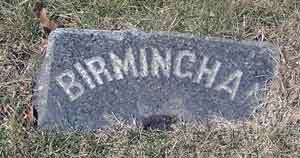
BERMINGHAM (or BIRMINGHAM), WILLIAM (1834-1899). Corporal, 182nd New York Infantry, Company A. Bermingham enlisted as a corporal on September 17, 1862, at New York City, and mustered into the 182nd New York on November 17. On September 22, 1863, he was reduced in rank to private. After being captured as a prisoner of war at Boydton Plank Road, Virginia, on November 17, 1864, he was paroled on an unstated date, and mustered out of service on July 15, 1865, at Washington, D.C. His last residence was on East 122nd Street in Manhattan. He died from erysipelas (acute bacterial skin infection). Section A, lot 8100, grave 938.
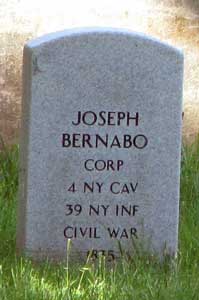
BERNABO (or BERNADO, BARNABO), JOSEPH (or GUISEPPE) (1835-1881). Corporal, 4th New York Cavalry, Company K; private, 39th New York Infantry, Company C. Originally from Italy, he enlisted as a private on January 1, 1862, at Washington, D.C., mustered into the 39th New York that day, and was discharged for disability on September 18, 1862, from Camp White at Harpers Ferry, West Virginia. He re-enlisted as a corporal on October 27, 1862, at New York City, mustered into the 4th Cavalry on November 15, but was dropped from the rolls on an unstated date. He last lived in New York. Bernabo died from pneumonia. Section 2, lot 5499.
BERNARD, ALEXANDER (1839-1904). Private, 24th New York Cavalry. Born in Canada on Prince Edward Island, Bernard was a private in the 24th New York Cavalry. There are no further details about his service. His last residence was 447 60th Street in Brooklyn. Bernard died from nephritis. Section 203, lot 26453.
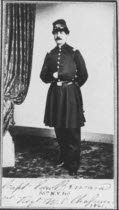
BERNARD, EDWARD (1830-1898). Captain, 65th New York Infantry, Company I; first lieutenant, 7th Regiment, New York State Militia, Company B; 11th New York Infantry, Company I. Bernard was born in New York. He was 5′ 8″ tall with black hair, black eyes and a dark complexion. After enlisting at New York City as a second lieutenant on April 17, 1861, he mustered into the 7th Regiment nine days later, was promoted to first lieutenant on May 10, and was discharged after 30 days on May 25, when he re-enlisted in the 11th New York and mustered in on June 4. Bernard fought at Bull Run, Virginia, in July 1861, before he resigned his commission on October 1 and enlisted and was commissioned into the 65th New York as a captain.
In Virginia, Bernard fought in the siege of Yorktown and at the following battles: Williamsburg, Fair Oaks, Seven Pines, and the Seven Days’ Battle. Wounded in the left leg at Malvern Hill, Virginia, on July 1, 1862, the bullet shattered the bones below his knee. He was carried to the beach of the James River and placed on a U.S. gunboat, the Delaware, before being transferred to the State of Maine, a hospital ship, at Harrison’s Landing and taken to Philadelphia, Pennsylvania. From there he was put on a train and sent to New York City, arriving on July 11, 1862, where doctors found that the muscles of his leg had retreated and the wound had abscessed. After an operation to repair the muscle damage, Bernard recuperated for many months at the home of his sister, but the damage to his leg was permanently disabling. The wound remained open and continued to ooze, needing on-going care. He resigned that December and was officially discharged October 27, 1863, after being mentioned in official orders.
In 1874, Bernard applied for and received an invalid pension, certificate 137,247. At that time, he worked as a clerk and weighed 200 pounds. Dr. Lewis Sayre, in his supporting documentation, wrote that much bone was lost in his left tibia and fibula ultimately shortening that leg by half an inch. Sayre wrote of Bernard’s original wound “with one or two exceptions the largest amount of pus I ever saw contained in a single abscess….” He went on to say that the bone fragments removed from the injury site filled “an ordinary teacup” and that a small piece of bone still remains that oozes and needs continual attention resulting in a permanent disability. In further support of Bernard’s application for the invalid pension, Robert B. Scott, a first lieutenant in the 65th wrote an affidavit testifying that he witnessed Bernard’s injury at Malvern Hill. “I saw him fall in the field. I detailed two privates from the company to take him off the field. The army retired and left him behind in their charge….It is within my personal knowledge that his wound was very severe and that he was confined to his house for a long time and that his wound is still unhealed…”
According to the 1880 census, Bernard was employed as a hardware clerk; his death certificate notes that he was a manager. The Veterans Census of 1890 confirms his military service. He last lived at 520 Monroe Street in Brooklyn. His death was attributed to apoplexy. A descendant, who researched the family’s genealogical records, discovered that he left his personal estate valued at $1,360 to his sister, Elizabeth Marshall. Section 65, lot 1621.

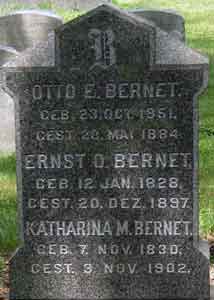
BERNET (or BRENT), ERNST (or ERNEST) OTTO (1828-1897). Captain, 20th New York Infantry, Company E. Of German birth, he came to the United States in 1848 sailing from Antwerp, Belgium, aboard the Lady Arabella. In 1857, he was employed in the liquor business at 132 Essex Street in Manhattan. He enlisted at New York City on May 3, 1861, and was commissioned into the 20th New York as a captain three days later. In February and March of 1862, he was assigned to Camp Hamilton, near Fortress Monroe, Virginia. Also known on the rolls as Ernest Brent, he resigned on July 10, 1862.
Remaining active in military affairs, he was promoted to major of the 96th Regiment, New York State Militia, in 1866. In civilian life, he was the proprietor of the Terrace Garden, an establishment that presented Sunday concerts and daily musical and dramatic performances (in German) at East 58th Street and Lexington Avenue in Manhattan according to advertisements in The New York Herald in 1869 and 1871. In March 1878, Bernet became an American citizen. The 1880 census and local directory listed him as a clerk in a wine store at 295 Bowery in Manhattan. On October 21, 1881, he joined the G.A.R. He was listed as working in wines at 295 Bowery in the New York City Directory for 1891-1892.
At the time of his application for a passport in 1895, Bernet was 5′ 6″ tall with a high forehead, blue eyes, gray hair, a moustache and a fair complexion. In 1896, he applied for and was granted an invalid pension, certificate 933,005. At the time of his death, he lived at 435 East 116th Street in Manhattan. Section 166, lot 24683, grave 2.
BERRIAN, WILLIAM H. (1845-1886). Private, 5th New York Veteran Infantry, Company K. Born in New York State, Berrian enlisted at New York City as a private on April 6, 1865. On that date he mustered into Company K of the 5th Veterans from which he was discharged at Hart’s Island, New York Harbor, on August 21, 1865. His last address was on Bailey Avenue in the Bronx. Berrian died from heart disease. Section 85, lot 6830.
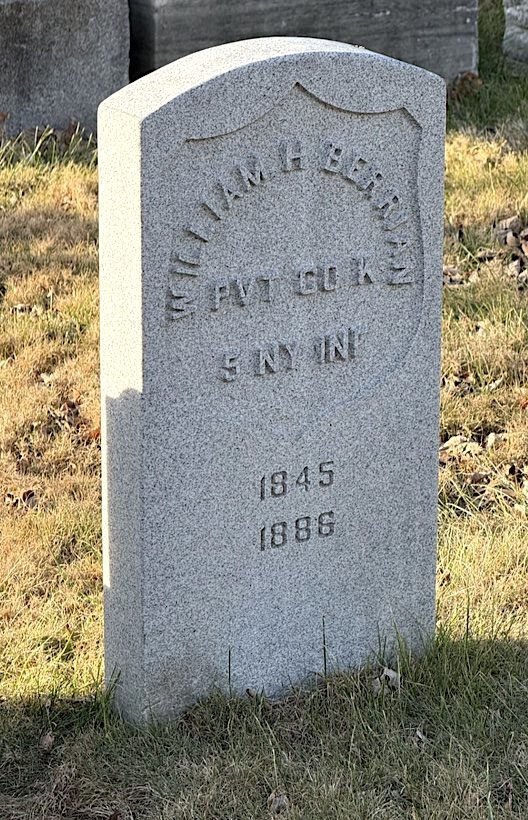
BERRIE, JAMES H. (1826-1896). Private, 13th Regiment, New York State Militia, Company B. A native of Scotland, he immigrated to the United States in 1848. Berrie served as a private for three months in the 13th Regiment in 1861, mustering out at the termination of his enlistment. He is listed as a tailor in the Brooklyn Directories for 1870-1873 and 1890-1892; in the latter directory, he was recorded as living at 148 Tillary Street. He joined the Devin Post #148 of G.A.R. on September 9, 1887. In 1892, he applied for and received an invalid pension, certificate 652,766.
As per his obituary in the Brooklyn Standard Union, which confirmed his Civil War service, he was a Freemason and a member of the Sons of St. George, a fraternal society originally founded in Philadelphia in 1772 for assistance to Englishmen. Members of those lodges and members of the Devon Post were invited to attend his funeral. His last residence was 148 Tillary Street in Brooklyn and his cause of death was listed as old age. His funeral took place at the City Hall Chapel on Concord and Gold Streets, where he had been a member for 30 years. Shortly after his death in 1896, Ann E. Berrie was granted a widow’s pension, certificate 490,031. Section 135, lot 14964, grave 804.
BERRIEN, THEODORE (1843-1886). Private, 56th New York Infantry, Company F. A Brooklynite by birth, he enlisted as a private at New York City on March 30, 1865, mustered into the 56th New York on that date, and mustered out on October 17, 1865, at Charleston, South Carolina. His last residence was 506 West 125th Street in Manhattan. He died from tuberculosis. Section 105, lot 6916.
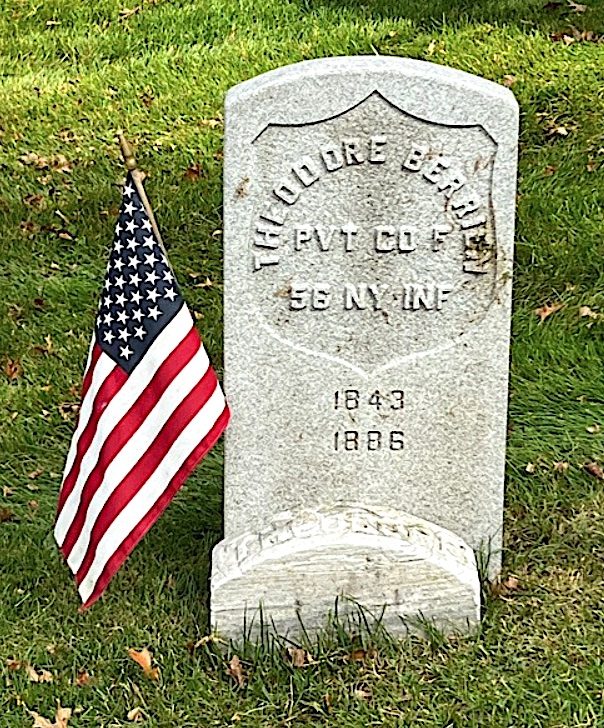
BERRY, ABRAHAM J. (1797-1865). Surgeon, 38th New York Infantry; assistant surgeon, 47th New York Infantry. According to a descendant, Berry was born in 1797 although other sources list 1799 as his birth year. His family was among the original settlers of Williamsburg (originally spelled, Williamsburgh) and owned much of the land in that area. He was renowned for his heroism as a physician during the 1832 cholera epidemic in Kings County. Dr. Berry is listed as a member of the Medical Society of the City and County of New York in the New York Evening Post, May-October 1841 and May-October 1842, the New York Tribune, March-September 1843 and in the New York Spectator, 1840-1845. The first mayor of the independent city of Williamsburg in 1852, Berry initiated a proposal that resulted in Williamsburg’s consolidation into Brooklyn in 1855; at the time of the consolidation, the “h” was dropped from the spelling of Williamsburgh. In addition, he established ferry connections to New York City. He is listed as a physician living at 44 South 9th Street in the Brooklyn Directories for 1858 and 1858-1862.
During the Civil War, Berry enlisted as a surgeon when he was in his 60’s at New York City on June 17, 1861, and was commissioned into the 38th New York’s Field and Staff two days later. The descendant possesses two letters from Dr. Berry to his 12-year-old grandson, Berry Egan, describing conditions from Camp Scott, near Alexandria, Virginia, on July 17, 1861, an excerpt of which follows:
… there is a great difference, my boy, in seeing soldiers marching through the streets with every comfort around them than seeing them as I do every day and night, obliged to eat just what is portioned out to them, exercised and tossed about, rain or shine, ready at all times to meet a foe, who at a moment may send them into another world. I have seen them, my son, after marching and getting wet, lay down in their tents, wet and on the bare ground and hungry at that. And, when they are sick they have no mother to nurse them and when they die they have no one but their comrades to close their eyes and they alone follow them to their resting spot, a hole dug in some remote corner of a field they may be located in for the time, accompanied with the solemn muffled drum and left alone after a volley is filled over their graves….
In a second letter, dated October 22, 1861, from Camp Scott, Berry wrote:
I send you this flag for it is the emblem of Union, and it is to restore it throughout the Country where it has been desecrated and trampled underfoot that your Grandfather left you and all the comforts we once enjoyed together to sleep in a tent in Virginia so that he could take care of the poor, wounded and sick soldiers who may have a little boy he has left far away and who may never see him again. You must think now hard it is for men to make such sacrifices for you-such a little boy that you may have a home when you may one day be able to protect those who have watched over you with so much care….
In July 1862, he was in charge of more than 300 patients at White House, Virginia, when General McClellan retreated to Harrison’s Landing. During a period of confusion when the Army left that area, the injured and Berry were left behind. He then led the effort to move the sick and convalescents to the James River. He was discharged on December 9, 1862. After re-enlisting at Brooklyn as an assistant surgeon on June 17, 1863, he was commissioned into the 47th New York’s Field and Staff, and mustered out at Brooklyn after serving for 30 days on July 23. He died of exhaustion at his home in Brooklyn at 85 South 9th Street. He was survived by his wife, Mary Caroline Egbert Berry, and four children. A street and playground in Williamsburg, Brooklyn, are named for his family. Section 123, lot 3622.
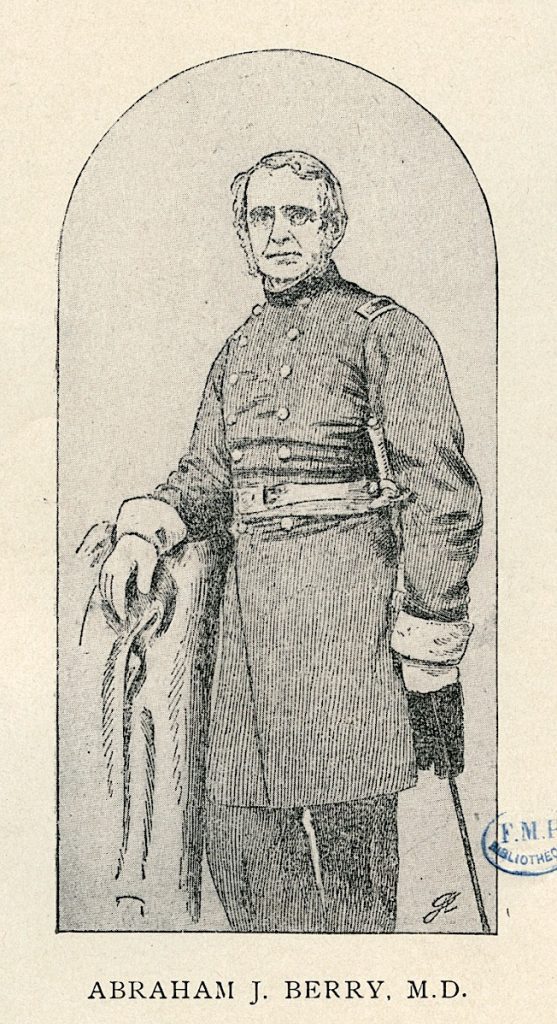
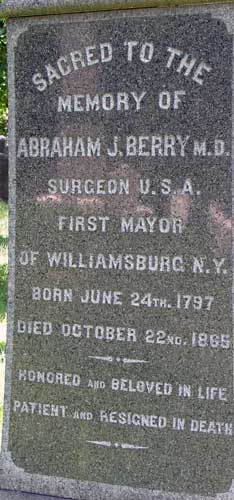
BERRY, ALPHONSO (or ALPHONZO) H. D. (1848-1900). Private, 84th Regiment, New York State National Guard, Company B. Berry served for 100 days with the 84th National Guard in 1864. In 1896, he applied for and was granted an invalid pension, certificate 934,441. He last lived on 99th Street and Fourth Avenue in Brooklyn. His death was attributed to nephritis. Christina Berry, who is interred with him, applied for and received a widow’s pension, certificate 574,912. Section 136, lot 28307.
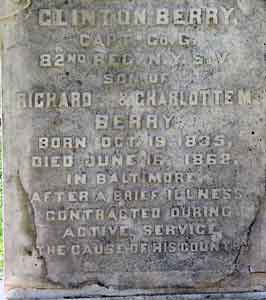
BERRY, CLINTON (1835-1862). Captain, 82nd New York Infantry, Company G. In 1853, Berry, a native New Yorker from Williamsburg, Brooklyn, was appointed as a cadet to the United States Military Academy at West Point. The census in 1860 listed him as a clerk. After enlisting as a second lieutenant on June 1, 1861, he was immediately commissioned into the 82nd New York. He quickly rose to first lieutenant on October 22, and to captain on January 1, 1862. An article in The New York Times dated December 28, 1861, noted that Berry was with the regiment at Poolesville, Maryland, and had fought at Bull Run and Edwards’ Ferry, Virginia. He last resided at 29 East 37th Street in Manhattan. On June 16, 1862, he died of typhoid fever at Baltimore, Maryland. Section 178, lot 14068.
BERRY, LLOYD W. (1834-1909). First lieutenant, 11th New York Infantry, Company E. A native New Yorker, Berry enlisted there as a second lieutenant on April 20, 1861, was commissioned into the 11th New York that day, was promoted to first lieutenant on October 4 of that year, and mustered out at New York City on June 2, 1862. In 1903, his application for an invalid pension was granted, certificate 1,080,043. He last lived on Samsone Street in Philadelphia, Pennsylvania. His widow, Ella Berry, received a pension in 1909, certificate 691,718. Section 11, lot 2654.
BERT, JOHN (1835-1879). Sergeant, 11th Regiment, New York State National Guard, Company F. Originally from Germany, Bert enlisted at New York City as a sergeant on May 28, 1862, mustered into the 11th Regiment on that date, and mustered out after three months on September 16 at New York City. His last residence was 27 West 56th Street in Manhattan. Section 106, lot 10043.
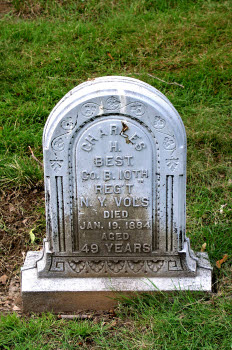
BEST, CHARLES H. (1834-1884). Private, 10th New York Infantry, Company B. Born in New York, Best enlisted as a private at New York City on October 10, 1861. On February 13, 1863, he was discharged for disability at Convalescent Camp, Virginia. In 1872, his application for an invalid pension was approved, certificate 255,726.
As per the 1876-1878 New York City Directory, Best was a polisher. The 1880 census recorded him as working as a varnisher and polisher. His last residence was 60 Division Street in Manhattan. Best died from heart disease. Amelia Best applied for a widow’s pension in 1884, application 314,625, but there is no evidence that it was certified. Section 13, lot 19694, grave 30.
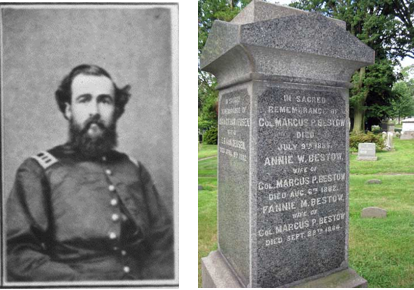
BESTOW, MARCUS P. (1834-1885). Colonel, lieutenant colonel and major by brevet; major, United States Volunteers Adjutant General’s Department; first lieutenant, 26th Ohio Infantry, Company A. Bestow is not buried at Green-Wood; the cenotaph in his family’s lot honors his memory. Born in Coolville, Ohio, he moved to Cincinnati in 1853 where he was employed as a clerk in a dry goods store eventually becoming chief salesman. He was a lawyer at the onset of the Civil War.
Bestow enlisted as a second lieutenant on July 31, 1861, and was commissioned into the 26th Ohio that day. The 26th was part of Hascall’s Brigade, Wood’s Division. He was promoted to first lieutenant on June 23, 1862, and was discharged for promotion on December 23 of that year when he was commissioned into the United States Volunteers Adjutant General’s Department as a captain and assistant adjutant general.
Brigadier General Thomas J. Wood, his commanding officer, cited Bestow twice for his cooperation; first on September 29, 1863, for his performance of duties during the “arduous campaign at Chickamauga,” and then on November 24, 1863, for his gallantry and intelligence noting that he was slightly wounded by a shell fragment at Mission Ridge, Tennessee. On March 13, 1865, Bestow was promoted by brevet to major, lieutenant colonel, and colonel, for “meritorious service during the war” and for “gallantry at the battle of Nashville, Tennessee, and the subsequent pursuit of the insurgent army under General Hood.” According to his obituary in The New York Times, he was promoted to major in June 1865, and mustered out in 1866. General Wood said of him at the time of his muster out, “Colonel Bestow’s desk duties were performed faithfully, intelligently, and conscientiously. In the field, whether on the march or on the battlefield, he was distinguished for activity, courage, zeal, and intelligence. His personal gallantry was of a high order. He participated with me in the battles of Stone River, Chickamauga, Mission Ridge, and all the affairs and battles of the Atlanta campaign, and in the crowning victory, Nashville. He received three brevets ‘for gallant and meritorious duty.’ His leading traits were an ardent patriotism, a zealous and conscientious sense of the obligation of duty, great personal gallantry, and thorough loyalty to comrades and friends.”
After returning to his law practice in Ohio, Bestow moved to Brooklyn four years later where he was admitted to the New York Bar and built up a large and lucrative practice. As per the Brooklyn Directory for 1870-1873, he was a lawyer with offices at 14 Wall Street; he lived at 2562 Sackett Street. He is listed as a lawyer in the New York City Directories for 1875-1876, 1877, and 1876-1878; his practice was at 120 Broadway in Manhattan and his home was in Brooklyn. The New York City Directory for 1880-1882 states that Bestow’s law practice was at 156 Broadway; he then lived at 438 Franklin Avenue in Brooklyn. A staunch Republican, he was a member of the New England Society and the Lincoln Club. His application for an invalid pension was granted in 1882, certificate 452,929.
He died suddenly at his father’s house, his childhood home, in Coolville, Ohio, leaving his 13 year old daughter an orphan. His death was attributed to an intestinal illness that he contracted while in service and continued to recur throughout his life. Although his obituary notes that his body would be sent to Green-Wood for burial, that is an error; he is buried at Coolville Cemetery. His daughter, an unnamed minor, received a pension after his death, certificate 266,142. Section 179, lot 14414.
BETTS, THEODORE (1844-1876). Private, 9th New York Infantry, Company A. After enlisting as a private at New York City on April 23, 1861, he mustered into the 9th New York on May 4, and mustered out on May 20, 1863, at New York City. In 1874, he was employed as a clerk. He last lived at 482 Warren Street in Brooklyn where his death was listed as a casualty. Mary Betts, his widow, received a pension in 1891, certificate 337,314. Section 188, lot 15237.
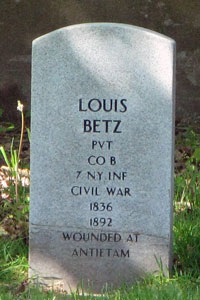
BETZ, LOUIS (1836-1892). Private, 7th New York Infantry, Company B. Of German birth, Betz enlisted as a private at New York City on April 23, 1861, and mustered into the 7th that same day. He was wounded at Antietam, Maryland, on September 17, 1862, and mustered out on May 8, 1863, at New York City. In 1870, his application for an invalid pension was granted, certificate 114,281. He last lived at 323 East 8th Street in Manhattan. Elizabeth Betz, received a widow’s pension after his death from tuberculosis in 1892, certificate 371,826. Section 2, lot 5499, grave 109.
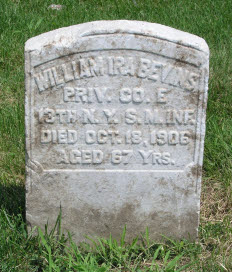
BEVINS (or BEVIN), WILLIAM IRA (1839-1906). Private, 13th Regiment, New York State Militia, Company E. Bevins, a native of Brooklyn, served for three months in 1861 in the 13th New York State Militia. His pension application was approved in 1906, certificate 1,129,768. He last lived at 321 3rd Street in Brooklyn. Bevins died from heart disease. Mary Ann Bevins received a widow’s pension shortly after his death in 1906, certificate 621,557. Section 136, lot 28070, grave 345.
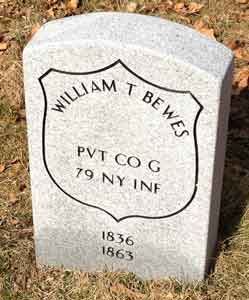
BEWES (or BEWS), WILLIAM T. (1836-1863). Private, 79th New York Infantry, Company G. Originally from Scotland, he was employed as an accountant at the time he enlisted as a private at New York City on May 13, 1861. He mustered into the 79th New York on May 28, and was discharged for disability at Washington, D.C., on July 29 of that year. On March 25, 1863, he was awarded an invalid pension, certificate 508,122. Bewes last lived on Washington Avenue in Brooklyn. The cause of his death was consumption. Catharine Bewes, his widow, received a pension shortly after his death, certificate 31,417. Section 115, lot 13536 (Soldiers’ Lot), grave 67.
BIBLE, CHARLES P. (1849-1910). Drummer, Confederate States of America. It is unclear where Bible was born; one source notes that he was born in Atlanta, Georgia, but his obituary states that he was born in Alabama. During the Civil War, Bible enlisted in Alabama and served as a drummer boy in the Confederate Army. As per his obituaries in the Brooklyn Standard Union and the Brooklyn Daily Eagle, both of which confirm his service in the Confederate Army, after the War he moved to Brooklyn and served as chief clerk of the Sixth District Municipal Court at 611 Fulton Street. He was a member of the Twelfth Assembly District Republican Club, the Logan Republican Club, the Freemasons and community service organizations.
Bible’s last residence was 447 9th Street in Brooklyn. According to his obituary in the Brooklyn Daily Eagle, he slipped while getting off a Seventh Avenue car (trolley) on his way home from work and sustained internal injuries which led to his death several days later. As per his obituary in the New York Herald, members of his Masonic lodge were invited to attend rites in his memory. His funeral was at Riker’s Funeral Parlor at 760 Carroll Street. A widower at the time of his death, he was survived by a daughter. Section 135, lot 27263, grave 64.
BIDDLE, GEORGE H. (1801-1884). Colonel, 95th New York Infantry. He was born George Hogg; early in his life, the family changed its name to Biddle. After an early career in the auction business, George Biddle joined the Army at the outset of the Mexican War, served on the staff of General Zachary Taylor as a colonel and fought at Chapultepec and Churubusco. After the war, he returned to civilian life.
Early in the Civil War, Biddle was authorized to recruit the 95th Regiment of the New York Infantry (the Warren Rifles) and enrolled on November 16, 1861, at age 59, at New York City. He mustered in as lieutenant colonel on December 20, 1861, and was promoted to colonel on March 6, 1862. Biddle saw action with the Army of the Potomac from Second Bull Run, Virginia, to Gettysburg, Pennsylvania. By December 1862, he was commanding the 2nd Brigade, 1st Division of the 1st Corps. He commanded the 95th in Virginia at the Battles of Fredericksburg, December 11-15, 1862; Pollock’s Mill Creek, April 29-May 2; and Chancellorsville May 1-3; and at Gettysburg on July 1, 1863. On the morning of the first day of the Battle of Gettysburg, he was shot through the lungs near McPherson’s Woods. Taken prisoner, he was freed by Union forces the following day. On October 9, 1863, he tendered his resignation, “for the reason that unmerited attempts have been made and are again set on foot to have me arrested, thereby casting reproach upon a man who has known of no fault excepting to deal mercy with justice, serve his country faithfully and his God.”
Biddle was a member of the Grand Army of the Republic and the Loyal Legion. His son, Thomas Biddle, served with the Confederate cavalry in Texas. Another son, George Edgar Biddle, was better known as the actor George Edgar. His daughter married a United States Navy officer. In 1873, his application for an invalid pension was granted, certificate 130,400. His last residence was at 175th Street and Madison Avenue in Manhattan. His cause of death was listed as “old age.” Section 106, lot 10499.
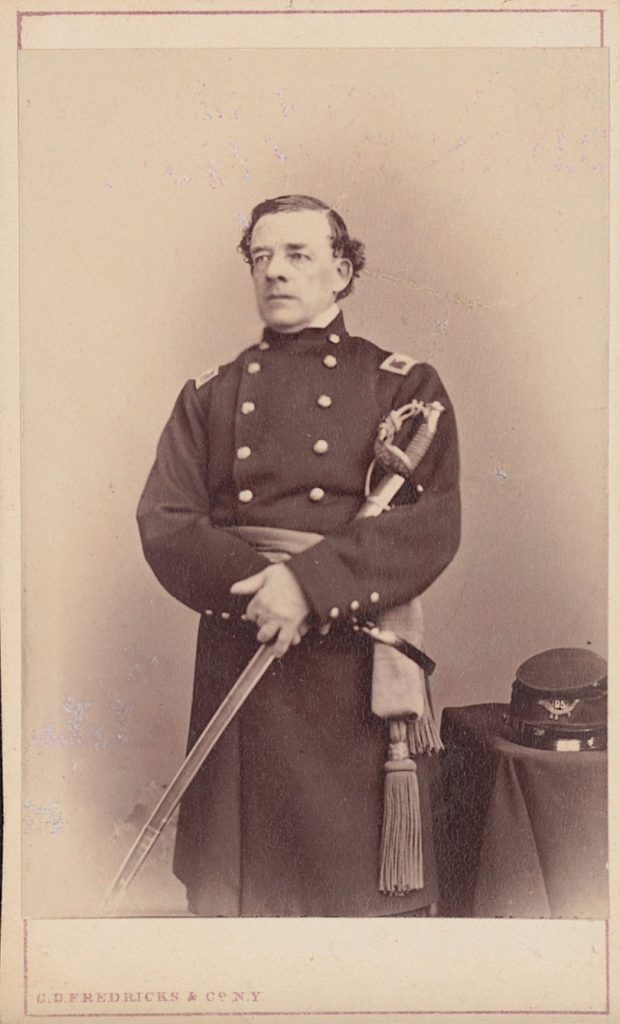
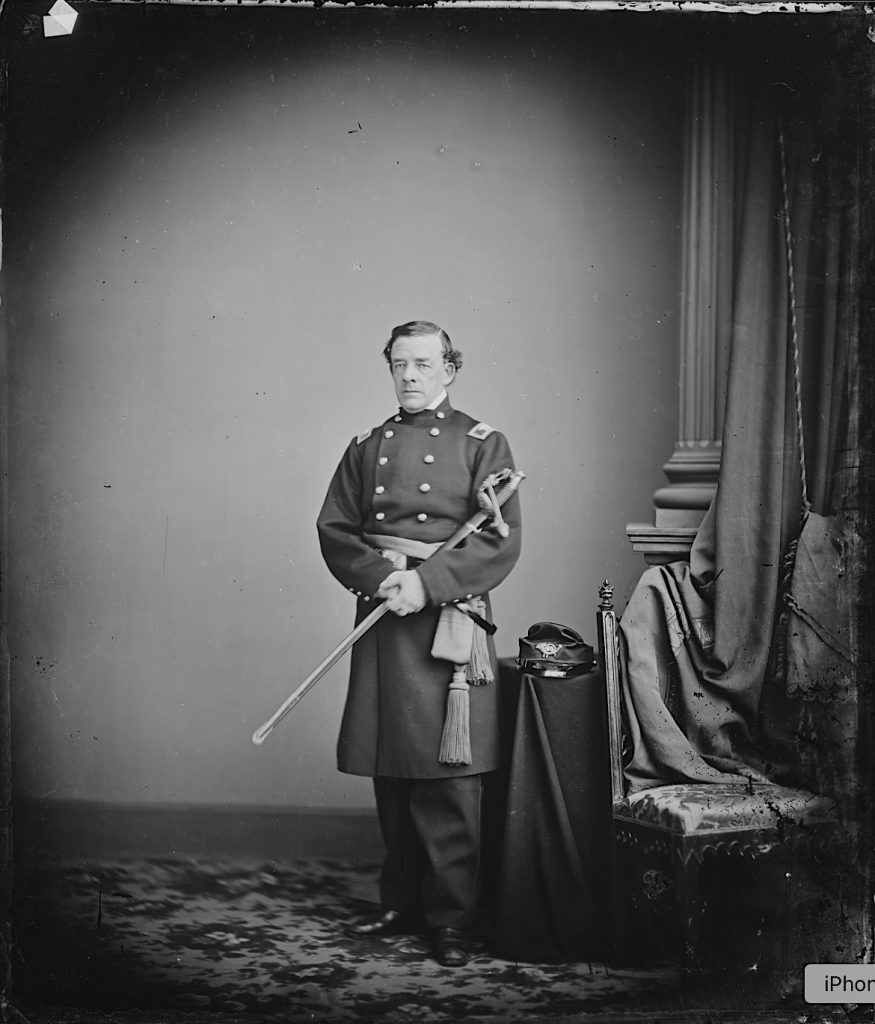
BIDDLE, JAMES E. (1844-1873). Private, 56th New York Infantry. A New York native, Biddle enlisted at New York City as a private on April 13, 1865, and mustered immediately into the 56th but was not assigned to a company. He mustered out the next month on May 8 at Hart’s Island, New York Harbor. His last residence was 57 Adelphi Street in Brooklyn. Biddle’s cause of death was tuberculosis. Section 51, lot 11556.
BIDWELL, WILLIAM E. (1843-1894). Sergeant, 16th Connecticut Infantry, Company G. Born in Hartford, Connecticut, and a resident of East Hartford, he enlisted there as a private on July 25, 1862, and mustered into Company G of the 16th Connecticut on August 24. On December 25, 1862, he was promoted to corporal and then became the company’s sergeant on March 6, 1863. On April 20, 1864, he was taken prisoner of war at Plymouth, North Carolina, and was paroled on December 10, 1864. His obituary noted that he was incarcerated at Libby (Richmond, Virginia) and Andersonville (Georgia) Prisons, spending eleven months in confinement. Bidwell was discharged on June 1, 1865.
Well-known in the jewelry business as a partner in James H. Hart & Company (which was liquidated about six months before his death), he also owned real estate and was a member of the Union League Club. Bidwell was listed in the Brooklyn Directory for 1873-1876 in the Brooklyn Directory for 1890-1892 as a jeweler on Bond Street and as a jeweler with establishments at 539 Fulton Street and 452 Gold Street. His last residence was 387 Jefferson Avenue in Brooklyn where he died from carbolic acid poisoning. An article about his death in The New York Times stated that he was in financial trouble, was estranged from his wife, and was due to make an accounting for an estate of which he was the executor. It could not be determined if his death was a suicide or an accident. His widow received a pension in 1901, certificate 507,344. Section 148, lot 17636, grave 6.
BIELITZ, CARL F. (1825-1893). Private, 29th New York Infantry, Company A. Born in Germany, he enlisted on May 7, 1861, at New York City, mustered into the 29th New York on June 4, and mustered out on June 20, 1863, at New York City. His muster roll indicates that he was paid $1,026 by New York State for his service. He last lived at 571 Atlantic Avenue, Brooklyn. Bielitz died from apoplexy. Section 86, lot 5229, grave 21.
BIERLEIN, GUSTAV (or GUSTAVE) J. (1845-1918). Private, 173rd New York Infantry, Company A. Bierlein was born in Brandenburg, Germany, in 1845, and had two younger brothers, according to his online biography on Find A Grave. During the Civil War, he enlisted at Brooklyn as a private and mustered into Company A of the 173rd New York. He was furloughed on October 10, 1863. His muster roll notes that he received that furlough for sickness at Baton Rouge, Louisiana, and was “not heard from since.” However, he was listed as absent/sick in October 1864 and in February 1865. He apparently returned to New Orleans and was listed as returned in May 1865, June 1865 and July 1865.
As per the 1865 New York State census, Bierlein was 20 years old and lived in Brooklyn with his parents and brothers; that census notes that the family lived in a brick house valued at $900. Although Bierlein applied for an invalid pension in 1870, application 388,171, there is no evidence that it was certified. At the time of the 1880 census, he was married to Josephine, had four children and a servant at their Brooklyn home and worked as a butcher.
Bierlein was mentioned in an article in the Brooklyn Daily Eagle on August 15, 1890. That article noted that he had been arrested for selling liquor without a license and that he was a saloonkeeper and member of the German Democrats. Apparently, the case arose from a dispute between factions of the Democratic Party who argued over the appointments of excise commissioners; Bierlein allegedly sold liquor without having a license signed by a newly appointed man—the case was moved to another jurisdiction.
The scandal of liquor licenses continued to involve Bierlein, who was considered “tough” to deal with. The same factions were involved in a subsequent dispute as per an article in the Brooklyn Daily Eagle on May 24, 1892. This time, Bierlein sought to open a new saloon in the fashionable area of Cropsey Avenue in Bath Beach and sought a liquor license, which was denied him. The decision was controversial because allegedly Bierlein used “plain and unvarnished English” when speaking to the excise board and threatened them with bodily harm; the chairman of the excise board, Rupert (Rufus) Werner, who had ruled against Bierlein two years earlier, owned a saloon in Bay Ridge, distinctly against the rules for serving on that board. The matter was then taken up by the Bath Beach Citizens’ Association as reported in the Brooklyn Daily Eagle on August 14, 1892. The group wanted to oust Excise Commissioner Werner for his scandal of being on the excise board and running a saloon, a clear violation of the law. The article noted that Bierlein would lose his license if Werner was ousted from office; it is unclear when Bierlein got the license.
On February 21, 1893, the Brooklyn Daily Eagle reported that Bierlein attended the Liquor Dealers’ Ball at Saengerbund Hall, a German venue. As per an article in the Brooklyn Daily Eagle on October 17, 1900, Bierlein was aroused by smoke when fire broke out in the basement of the Franklin House on Cropsey Avenue and Bay 13th Street, where he lived. The fire caused $5,000 in damages but was extinguished by firefighters before spreading to adjacent properties.
The 1902 New York City Directory lists Bierlein as a fish dealer. At the time of the 1905 New York State census, he lived in Brooklyn. On an unstated date, Bierlein married Ellen Moran. The 1910 census notes that he was married to Ellen and was a butcher; that census incorrectly indicates that he was born in New York. In 1912, his name was listed as among those who attended a reunion of the 173rd New York. Bierlein’s death certificate indicates that he was married and was employed as a butcher. He last lived at 39 Carlton Avenue in Brooklyn. As per his obituary in the Brooklyn Standard Union, his funeral was held at the F. Herbst & Sons Funeral Parlor at 697 Third Avenue in Brooklyn. Section 3, lot 21025, grave 371.
BIESELE, CHARLES (or KARL, CARL) EDWARD (or EDUARD) (1832-1882). Private, 1st Battalion, 29th New York Light Artillery, Battery A. Biesele, whose birth name was Karl Eduard Biesele, was a native of Baden, Germany. He immigrated to New York City in 1854. During the Civil War, he enlisted as a private at New York City on July 24, 1861, and mustered into Battery A of the 29th Light Artillery on August 12. His muster roll, which lists his name as Carl Biesele, notes that he was also borne on the rolls as Charles. The official muster-in roll, which lists his name as Charles Biesele, states that he was called to service with his battery, also known as the German Artillery Corps of Volunteers, on August 27 for a term of three years. He deserted on September 5, 1862.
According to his descendant, Biesele and others left their battery in Washington, D.C., because their unit, under the overall command of Major General Joseph Hooker, was disorganized and not involved in battle; the inactivity led many of the men to engage in unseemly behaviors and Biesele left for home. On October 21, 1867, Biesele became a naturalized citizen. At that time, he listed his occupation as shoemaker, listed his first name as “Carl,” and lived at 65 Lawrence Street in New York City. His descendant reports that Biesele, who eventually anglicized his name to Charles Edward Biesele, was a shoemaker in Greenwich Village throughout his lifetime. Section 114/115, lot 8999, grave 138.
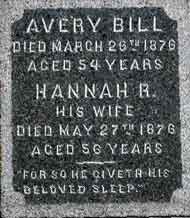
BILL, AVERY (1821-1876). Private, 7th Regiment, New York State National Guard, Company I. After enlisting at New York City as a private on May 25, 1862, he mustered into his company the same day, and mustered out after three months on September 5 at New York City. When the unit was reactivated a year later, he served for 30 days. He last resided at 144 South Portland Avenue, Brooklyn. He died from heart disease. Section 146, lot 22260.
BILLINGEE (or BILLINGE), BENJAMIN (1817-1865). Private, 7th Delaware Infantry, Company E. Originally from Bristol, England, his 1863 application for a passport described him as 5′ 7″ tall with a high forehead, blue eyes and dark brown hair. He enlisted as a private on an unknown date, mustered into the 7th Delaware Infantry on July 12, 1864, and mustered out the next month on August 12. Section 123, lot 15535.
BILLON, LOUIS (1824-1897). First lieutenant, 83rd New York Infantry, Company B. Originally from Neufchatel, Switzerland, Billon was an importer of watches whose business was at 75 Nassau Street in Manhattan, according to the Worldwide Masonic Directory for 1860. The Brooklyn Directory for 1857-1862 lists him as a watchmaker at the Nassau Street location. At age 37, Billon enlisted at New York City as a first lieutenant on May 27, 1861, was commissioned into the 83rd that day, and was discharged on January 7, 1862.
As per the 1862 Brooklyn Directory, he was a watchmaker at 76 Nassau Street in Manhattan. The Brooklyn Directory for 1863 lists Billon as a watchmaker and the Brooklyn Directories for 1868 and 1867-1870 list him as a jeweler; in all the directories, he lived at 392 Hicks Street. At the time of the 1870-1873 Brooklyn Directory, his establishment was at 576 Hicks Street. According to the censuses for 1870 and 1880, he was employed as a watch-maker. On March 16, 1876, an article in The New York Times described a bold robbery at the Billon’s jewelry store at 576 Hicks Street during which Billon and his wife disregarded the thieves’ orders to remain silent prompting a pistol attack on Mr. Billon who lost much blood in his fierce struggle. The robbers absconded with a tray of gold rings worth approximately $200. The Brooklyn Directories for 1880-1882, 1884-1886, 1892-1894, 1894-1896 and 1896-1898 note that he was a jeweler at 576 Hicks Street.
As per his obituary in the New York Herald, Billon was a Freemason; brethren from La Sincerité Lodge, L’Union Française and La Clemente Amitie Cosmopolite were invited to attend his funeral. His last address was 576 Hicks Street, Brooklyn. Billon died from cancer. Section 193, lot 24878, grave 1.
BILLOTTE, JOSEPH (1843-1894). Private, 5th New York Heavy Artillery, Company C. After enlisting as a private at Brooklyn on January 27, 1862, he mustered into the 5th New York Heavy Artillery that same day, and deserted at East New York on March 11. He last lived at 854 Atlantic Avenue in Brooklyn. His death was attributed to paralysis. Section 135, lot 27263, grave 686.
BINGHAM, ALONZO A. (1824-1868). Captain, 152nd New York Infantry, Company I. Bingham was a native of New York. After enlisting as a captain at Mohawk, New York, on October 10, 1862, he was commissioned into the 152nd New York from which he was discharged for disability on December 23, 1863. At the time of his death, he was a resident of the Atlantic Hotel in New York. Section B, lot 11005, grave 269.

BINKS, ALEXANDER (1841-1897). Private, 68th Pennsylvania Infantry, Company A. Born in England, Binks came to the United States in 1852. He enlisted as a private on August 18, 1862, and on that day mustered into Company A of the 68th Pennsylvania. He deserted on July 13, 1863. He also served as a private in the 4th Independent Battery of the New York Light Artillery although the dates of that service are unknown.
As per the Brooklyn Directory for 1867-1870 and the censuses of 1870 and 1880, Binks was employed as a chaser or engraver of metals. The Brooklyn Directory for 1890-1892 lists him as a chaser; he then lived at 468 Seventh Avenue. He last resided at 474½ 7th Avenue in Brooklyn. His widow, Harriet Binks, applied for a pension in 1921, application 1,169,928, but there is no certificate number. Recently, a U.S. box plate belonging to Binks when he was with the 68th Pennsylvania was found by a hobbyist using metal-detector while exploring Civil War sites. Section 135, lot 14964, grave 929.
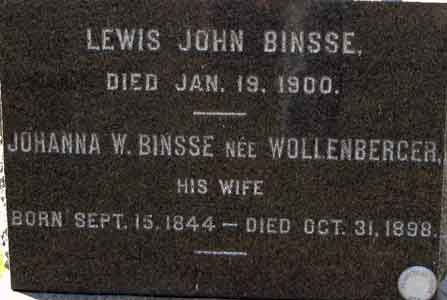
BINSSE, LEWIS (or LOUIS) JOHN (1833-1900). Captain, 40th New York Infantry, Companies E, B, F, and C; corporal, 38th New York Infantry, Company G; private, 55th New York Infantry, Company E. Born in Paterson, New Jersey, he enlisted as a private on January 27, 1862, and mustered immediately into the 55th New York, also known as the Garde Lafayette. On December 21, 1862, he transferred into the 38th New York, was promoted to corporal on February 1, 1863, and discharged on June 3, 1863. Binsse re-enlisted as a sergeant that same day and transferred into Company E of the 40th New York where he was reduced in rank to private on October 1.
Binsse re-enlisted on December 29, 1863, was promoted to sergeant on January 1, 1864, and to first sergeant on May 1 effective upon his transfer to Company B. He rose to second lieutenant on July 7 of that year and became a first lieutenant on September 15 effective upon his return to Company E. When Binsse was promoted to captain on December 21, 1864, he was transferred to Company C from which he mustered out on June 27, 1865, at Washington, D.C.
In 1894, he applied for an invalid pension, application 1,158,596, but there is no certificate number. As per his obituary in the New York Tribune, which confirms his Civil War service, he was related to a family that had a long history in New York. He last lived at 235 West 4th Street in Manhattan. Binsse died from nephritis. A widower, he had no children. Section 204, lot 30190, graves 1-5.
BIRCH (or BURCH), GEORGE I. (1842-1900). Private, 71st Regiment, New York State Militia, Company B. Birch served for three months in 1861 with the 71st Regiment. In 1894, his application for an invalid pension was approved, certificate 985,707. He last lived at 401½ 18th Street in Brooklyn. Birch died from cancer. His wife applied for and received a widow’s pension, certificate 499,996. Section 115, lot 21040, grave 3.
BIRCH, JAMES (1832-1873). Private, 15th New York Engineers, Company I. Birch, a native New Yorker, enlisted at New York City as a private on May 9, 1861, mustered into the 15th Engineers on June 17, and mustered out after two years on June 25, 1863. He last resided at 223 Sullivan Street in Manhattan. His death was attributed to tuberculosis. Section 115, lot 21040.
BIRCH, STEPHEN (1840-1881). Sergeant, 182nd New York Infantry, Company D; private, 69th Regiment, New York State Militia, Company D. Birch, who was originally from Long Island, New York, first served in Company D of the 69th Regiment for three months in 1861. When the 69th was re-activated for three months the next year, he re-enlisted as a private at New York City on May 26, 1862, and immediately mustered into the same company, now part of the National Guard, from which he mustered out after three months on September 3 at New York City.
During his second enrollment in the 69th, Birch was detailed to the Medical Department. On September 7, 1862, he re-enlisted as a private at New York City, mustered into Company D of the 182nd New York on November 17, was promoted to corporal on or about May 15, 1863, and rose to sergeant of his company on March 2, 1864. Birch was discharged from Carver Hospital at Washington, D.C., on June 14, 1865. His last residence was in Peekskill, New York. He died from heart disease. In 1885, his wife, Emily Birch, who is interred with him, applied for and received a widow’s pension, certificate 346,339. Section 143, lot 23758.

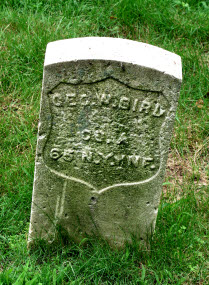
BIRD, GEORGE W. (1832-1864). Private, 67th New York Infantry, Company A; 65th New York Infantry, Company A. Bird enlisted at Brooklyn on May 14, 1861, and mustered into the 67th on June 20. He re-enlisted on December 25, 1863, and transferred into Company A of the 65th New York on September 1, 1864. After being wounded at Cedar Creek, Virginia, on October 19, 1864, he succumbed to that gunshot wound at Baltimore, Maryland, on November 4, and was buried five days later. On August 26, 1925, Jesse W. Mills (see), who served as a drummer for the 13th Regiment and the 51st New York Infantry during the Civil War, and was a member of the Ulysses S. Grant Post #327 of the G.A.R., applied for a government-issued gravestone on his behalf, citing Bird’s Civil War service. Section 25, lot 7405.
BIRD, JAMES H. (1836-1899). Private, 12th Regiment, New York State Militia, Company K. A native of New York State, Bird was a stone-cutter, following in the footsteps of his father, according to the 1860 census. He enlisted as a private in 1861 and mustered into the 12th Regiment where he served for three months before mustering out with his company.
In civilian life, Bird was listed as a mechanic on the 1870 census and was a butcher according to the 1880 census. His military service was confirmed on the 1890 Veterans Schedule for Neptune, New Jersey. In 1897, Bird applied for and received an invalid pension, certificate 958,592. His last residence was in Asbury Park, New Jersey. His death was attributed to heart disease. Shortly after his death in 1899, Sarah Bird, who is interred with him, applied for and received a widow’s pension, certificate 672,250. Section 21, lot 7974, graves 5 and 6.
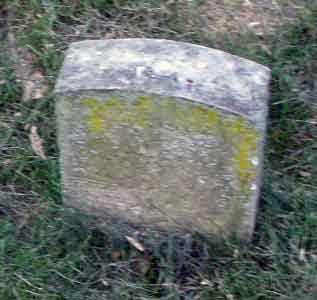
BIRD, WILLIAM J. (1841-1893). Private, 119th New York Infantry, Companies A and B. A native of Rochester, New York, Bird enlisted as a private at New York City on June 10, 1862, and mustered into Company A of the 119th New York on September 4. As per his muster roll, he was a machinist by trade who was 5′ 8″ tall with blue eyes, auburn hair and a light complexion. He was discharged for disability on February 27, 1863, at Stafford Court House, Virginia. According to his pension record, he also served in Company B of the 119th New York.
The Veterans Schedule for 1890 confirms his military service and states that dysentery caused his discharge. He died from tuberculosis at the New York Asylum for the Insane. Emmeline Bird, applied for and received a widow’s pension in 1893, certificate 384,811. Section 206, lot 21347, grave 179.
BIRDSALL (or BIRDSALLS), SAMUEL S. (1845-1867). Private, 176th New York Infantry, Company I. After enlisting on November 28, 1862, at Brooklyn, as a private, he mustered into Company I of the 176th on December 22. He deserted on January 4, 1863, at Jamaica, New York. His last residence was 153 Grand Street in Jersey City, New Jersey. Section 173, lot 20552.
BIRNEY, JAMES G. (or GILLESPIE) (1844-1870). Captain and first lieutenant by brevet; captain, 7th Michigan Cavalry, Companies C, A, and D; 1st Michigan Cavalry, Company C. James G. Birney IV was born in New Haven, Connecticut, the son of a lawyer and public servant. His grandfather, an abolitionist, ran for president on the Liberty Party ticket in 1840 and 1844. His family moved to Lower Saginaw, Michigan, around 1850, a wilderness at that time. When the community was organized as Bay County in 1857, both his father and grandfather were prominent citizens; his father was a state senator in 1858 and served for three months as lieutenant governor in 1860.
During the Civil War, Birney enlisted as a first sergeant at Bay City on October 14, 1862, rose to second lieutenant the next day, and mustered into Company C of the 7th Michigan Cavalry on November 13. The 7th Michigan Cavalry, also known as Custer’s Brigade, was led by Colonel, later General, George Armstrong Custer. During the cavalry charge at Gettysburg on July 3, 1863, Pennsylvania, he took the regiment’s colors after the color bearer was shot dead, rallied his men and used the flag staff as a weapon in hand-to-hand combat after his horse was shot from under him. Birney continued to lead his men until he was slashed in the head by a Confederate’s saber. Severely wounded, he was immediately taken prisoner but escaped after two days of confinement.
He rose to first lieutenant on August 1, 1863, effective upon his transfer to Company A, then became captain on March 18, 1864, effective upon his transfer to Company D. In 1864, the brigade was sent to Richmond, Virginia, and Birney was detached as a staff officer for some time. On September 17, 1865, he transferred into the 1st Michigan Cavalry. At that time, General Custer presented him with an engraved sword recognizing his actions at Gettysburg. The troops of the 1st Michigan were sent to Utah where they were engaged in the Mormon “rebellion” that was threatening the territory. When the troops were disbanded on March 11, 1866, Birney was held back, along with nine other captains, disciplined and given a dishonorable discharge. His father, a circuit judge and former lieutenant governor of Michigan, wrote a letter to General Pope, head of the Department of the Missouri, on his son’s behalf. In the father’s letter, he stated that his son was charged with neglect of duty and disobedience of orders for not submitting descriptive lists to his supervisors, but he had not had that responsibility for more than a year. His father, citing his son’s career of exemplary military service, concluded, “I wish if possible to have him reinstated before his return home that he not have the mortification of meeting his friends with such a stigma resting upon him.” It appears that many men were accused of actions that were “dishonorable” so that the Army would not have to reimburse them the costs of their trips home. In response to his father’s entreaty, and threats to involve Michigan’s Senator Zachariah Chandler to bring the case before Secretary of War Edwin Stanton, the War Department issued Special Order 267 on June 6, 1866, “By direction of the President, so much of Special Orders 130, Paragraph 6, issued March 22, 1866, from this office as dishonorably mustered out Captain James Birney, 1st Michigan Veteran Cavalry, is hereby revoked and is hereby honorably discharged the service of the United States as of the date of the aforesaid order…” He mustered out on June 6, 1866, at Salt Lake City, Utah. He was brevetted to first lieutenant and captain on March 2, 1867.
Remaining in service, Birney was commissioned into the 9th Cavalry, United States Army (rank unknown) in 1868, and assigned to Fort Davis, Texas. Fort Davis was home to the “buffalo soldiers,” a name given to African-American soldiers and former slaves by Indians in the region. The buffalo soldiers were instrumental in escorting settlers, railroad crews and cattle herds through the West. He died from typhoid fever in 1870 at Fort Davis, although some questioned those reports and linked his death to alcoholism. His infant son, Newton, who died in Texas at the age of seven months on December 27, 1868, was re-interred and buried with him at Green-Wood. Section 33, lot 6275.
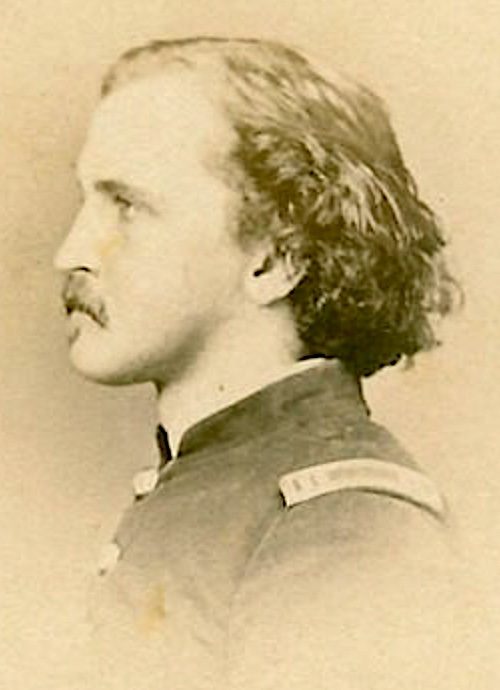
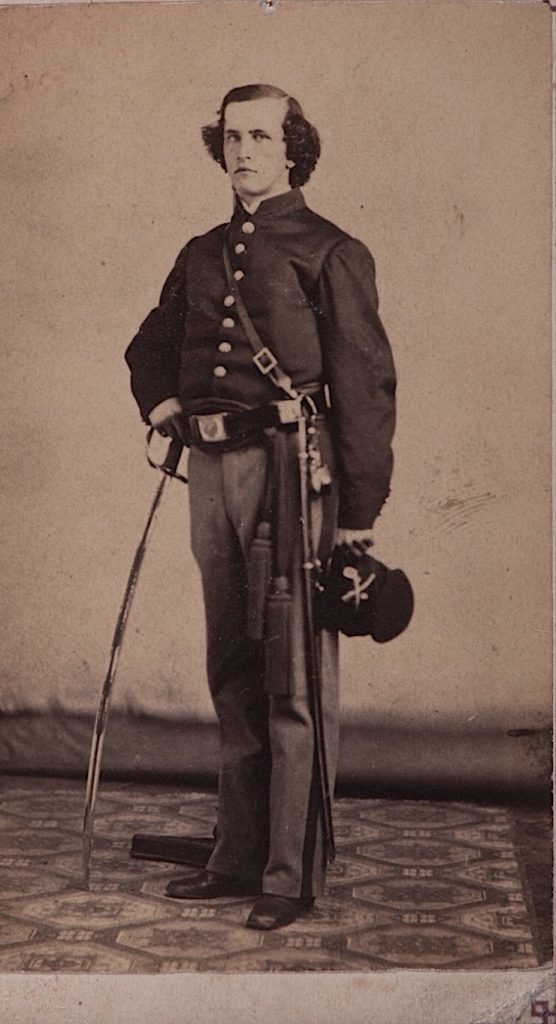
BIRRELL, WILLIAM (1828-1893). Private, 59th New York Infantry; U.S. Army, 12th Infantry. Born in Scotland, he served in the 59th New York (company unknown) and had prior service in the U.S. Army, 12th Infantry. Details of his service are unknown. As per the New York City Directories for 1875-1876 and 1876-1878, Birrell was a shoemaker who lived at 78 South Fifth Avenue. He last lived at 78 South 5th Avenue, New York City. His death was attributed to prostate cancer. Section 115, lot 4196, grave 566.
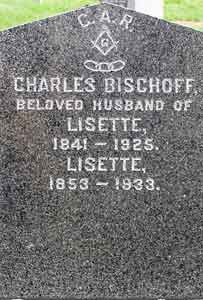
BISCHOFF (or BISHOP), CHARLES (1841-1925). Private, 6th Connecticut Infantry, Company A. A German native, Bischoff was a resident of Bethel, Connecticut, when he enlisted as a private on October 19, 1863, and mustered into the 6th Connecticut that day. He was wounded on August 14, 1864, at Deep Bottom Run, Virginia, losing the sight in his right eye and suffering a wound to the left leg. He was discharged for disability on June 2, 1865. On June 23, 1865, he applied for an invalid pension that was granted under certificate 54,811.
After the War, Bischoff was a member of the G.A.R. The 1910 census notes that he was a naturalized citizen who was self-employed in the real estate industry and able to read and write. He last lived at 9434 220th Street in Queens, New York. His death was attributed to heart disease. In 1925, Lisette Bischoff, who is interred with him, applied for and received a widow’s pension, certificate 967,972. Section L, lot 18617.
BISHOP, EDWARD A. (1836-1875). Private, 79th New York Infantry, Company A; 63rd New York Infantry, Company C. A native of New York City, Bishop enlisted there as a private on May 13, 1861, and mustered into the 79th New York fifteen days later. He was taken as a prisoner of war on July 21, 1861, at Bull Run, Virginia, was paroled about two days later at an unstated place, and mustered out on May 24, 1862, at Washington, D.C. After re-enlisting on December 17, 1863, at New York City, he immediately mustered into the 63rd New York where he served until he mustered out on December 17, 1863, at Washington, D.C. He last lived at 270 William Street in New York City. Bishop died from consumption. Section 15, lot 17263, grave 849.
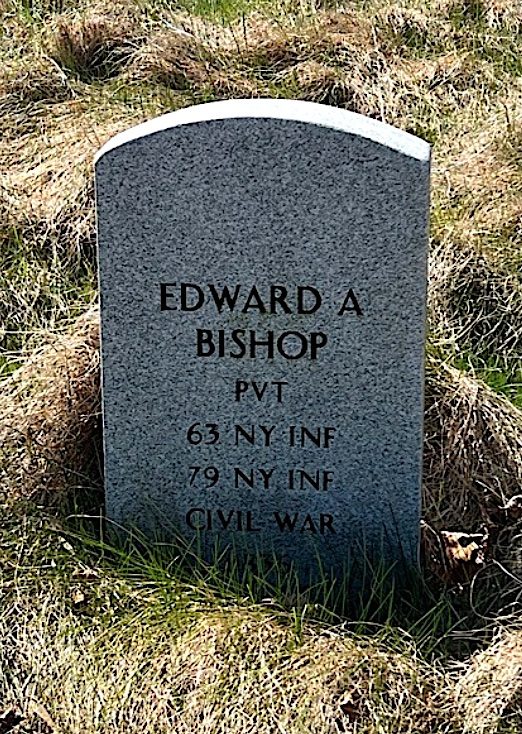

BISHOP, GEORGE W. (1830-1898). First lieutenant, 5th New York Light Artillery, Company F. After enlisting at Brooklyn as a first lieutenant on August 15, 1861, Bishop was commissioned three months later on November 7, 1861. He resigned the following year on February 11, 1862.
The 1870 census noted that Bishop was a machinist living in Stanford, Connecticut. In 1880, he was living in Brooklyn and was still employed as a machinist. Bishop was also an inventor who had nine patents. In 1891, he applied for and was granted an invalid pension, certificate 886,311. His last address was 868 Dean Street in Brooklyn. Emaline Bishop, who is interred with him, applied for and received a widow’s pension after his death from pericarditis in 1898, certificate 471,801. A tribute to Bishop, written by his great-great granddaughter in 1999, for Memorial Day, appears below. Section 3, lot 4647, grave 4.
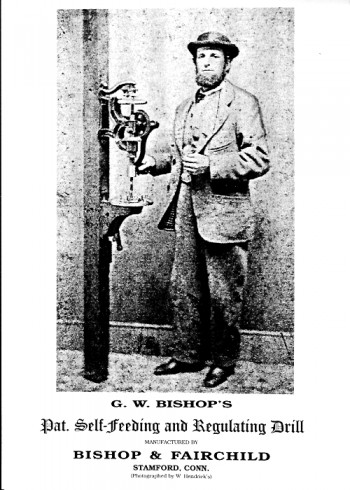
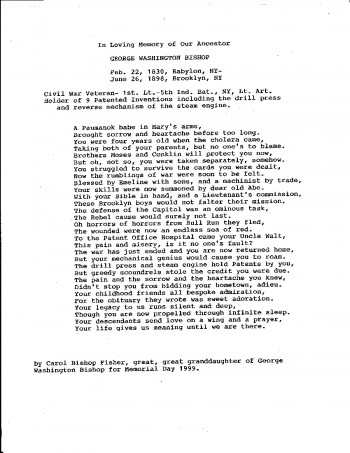
BISHOP, JAMES LYNCH (enlisted as BROWN, JAMES) (1847-1918). Landsman, United States Navy. His obituary in the Brooklyn Standard Union of January 18, 1918, reports that he was born in Brooklyn in 1847. According to his death certificate, his mother had been born in Brooklyn and his father was from England.
His pension index card records that he enlisted in the Navy in 1863 as James Brown, served as a landsman, and was discharged in 1865. That same document notes that he served on the North Carolina and the Princess Royal. It also records that he served in the 14th United States Infantry and the 12th United States Infantry from 1866 to 1869. His obituary confirms he was a Civil War veteran.
The 1870 census reports that he was living in Brooklyn, unemployed, with three members of the Street family. In 1871, James married Emeline Powell in Brooklyn. By the time of the New York State census of 1875, he was head of his household and working at a druggist and sundries business. He and Emeline then had two daughters, Florence (two years old) and Bertha (one). By 1880, he was a hose dealer; there were two children in the family: Florence and Alice; Bertha was not listed. As of 1900, the Bishops were living at 479 9th Street; Alice was no longer living with them. James applied for an invalid pension in 1911; it was granted as certificate 1,165,333.
According to his obituary, he was a member of the George Crockett Strong Post #534 of the Grand Army of the Republic. As per his obituary in the Brooklyn Eagle, he had worked for years as the New York representative for the Allen Fire Department Supplies Company. Green-Wood’s burial records list his cause of death as arteriosclerosis. Retired, he died after a brief illness at the home of his daughter at 1402 Beverly Road in Flatbush, Brooklyn. He was survived by his wife, two daughters, and a sister. His widow, Emeline, applied for a widow’s pension soon after his death in 1918; no certificate number is recorded. Section 36, lot 10744.
BISHOP, NATHAN (1808-1880). Educator and philanthropist. Born in Vernon, New York, he attended Brown University. It took him an extra year to graduate from college because of his responsibilities as tutor, bell-ringer, milker of the president’s cows, and others. After his graduation he served Brown successively as tutor, member of the board of trustees, solicitor of subscriptions to finance the reorganization plan he had drafted, and member of the Board of Fellows. He was superintendent of the Providence, Rhode Island, public schools 1839-1851, during which he made them as good as any in the country. He was superintendent of Boston public schools 1851-1857. He then moved to New York City, where he engaged in philanthropy.
Bishop chaired the executive committee of the United States Christian Commission during the Civil War. The Christian Commission was founded in 1861 in New York City as a private organization. Its staff followed the Union Army to provide both goods and assistance as well as to encourage soldiers in their religious lives. Unlike the Sanitary Commission, whose mission was secular, the Christian Commission was evangelical and strove to convert individuals to Christianity. The Christian Commission was heavily involved after the Battle of Gettysburg.
In 1867, Bishop was appointed to the Board of State Commissioners of Public Charities. He was named a trustee of Vassar College and was elected to the board of the American Bible Society. He was also a leader of the New York Sabbath Committee, the American Branch of the Evangelical Alliance, and the American Baptist Home Mission Society. In 1869 President Grant appointed him to the Board of United States Indian Commissioners. He contracted malaria on a trip to the tribes of the Southwest and never fully recovered from it. Section 25, lot 2908.

BISSELL, EUGENE (1839-1909). Private, 83rd New York Infantry, Company F. Bissell was born in Suffield, Connecticut, and was a salesman in New York City at the time of his enlistment at Washington, D.C., on June 8, 1861. Sent to the General Hospital in Alexandria, Virginia, in 1862, he was declared unfit for duty due to tuberculosis and remained there until he was discharged for disability on July 28.
After the war, Bissell was a wholesale auctioneer and merchant who founded the Hardware Club of New York City. This employment information was confirmed by the censuses of 1870 and 1880. The New York City Directories of 1875-1876, 1877, 1885-1886, and 1890-1892 all note that he was in the auction business and lived in Brooklyn. Although his pension record incorrectly cited the year of death as 1910, the information about Bissell’s soldier history is the same as above. He received a pension in 1904, certificate 1,089,172.
According to his obituary in The New York Times, he was a member of the Sons of the Revolution, Veterans of the 9th Regiment, and the Lafayette Post #140 of the G.A.R. At the time of his death, he was the proprietor of an auction house that bore his name at 8 Mercer Street in Manhattan. Notice of his sudden death was announced in the New York Herald and in the Brooklyn Daily Eagle. His home was at 210 Berkeley Place in Brooklyn. Section 198, lot 32521.

BLACK, EDMUND (or EDWIN) J. P. (1837-1861). Private, 84th New York (14th Brooklyn) Infantry, Company E. A New Yorker by birth, Black enlisted at Brooklyn as a private on April 18, 1861. He mustered into the 14th on May 23, was accidentally wounded by a gunshot and died on either July 19 or 20, 1861, at Washington, D.C. His name appeared on the bodies in transit list. On May 11, 1867, his father was awarded a pension, certificate 121,445. Section 49, lot 9026.
BLACK, RAMSAY C. (1834-1862). Private, 1st United States Sharpshooters, Company H. Born in New York, he enlisted as a private and served in the 1st United States Sharpshooters. He died in Philadelphia, Pennsylvania, of typhoid fever on August 26, 1862. His last residence was at 144 West 29th Street in Manhattan. Section 1, lot 8138.
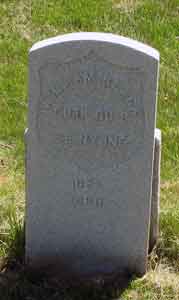
BLACK, WILLIAM (1825-1890). Corporal, 55th New York Infantry, Companies K and B. After enlisting as a corporal at New York City on August 16, 1861, Black mustered into Company K of the 55th New York on August 28. He was reduced in rank to private on March 30, 1862. Wounded at Seven Pines, Virginia, on May 31, 1862, he was transferred to Company B on October 1, and discharged for disability on November 20, 1862, at New York City. He last lived at the Soldiers’ Home in Bath, New York. His death was attributed to asthma. Section 114, lot 8999, grave 210.
BLACKWELL, JOHN (1834-1870). Private, 173rd New York Infantry, Company I. Of Irish birth, Blackwell enlisted on September 27, 1862, at New York City, mustered into the 173rd New York on November 10, and deserted while on board a ship in New York Harbor the next month on December 9. He last lived in Scarborough, New York. Blackwell died from heart disease. Section D, lot 7078, grave 11.

BLACKWOOD, BALTIMORE (1833-1870). Corporal, 52nd Regiment, New York State National Guard, Company D. He is likely the Baltimore Blackwood who is identified as a boot-fitter in the 1858 Brooklyn Directory. During the Civil War, Blackwood served with the 52nd Regiment for 30 days in 1863. He is listed as a painter in the 1863 Brooklyn Directory; he then lived on Gold Street. The 1866 Brooklyn Directory reports that he was a fastener. The 1867-1870 Brooklyn Directory lists him as a painter who lived on Herkimer Street near Buffalo Avenue. His last residence was on Herkimer Street in Brooklyn. Section 177, lot 13864.
BLACKWOOD, CLINTON R. (1841-1891). Private, 84th New York (14th Brooklyn) Infantry, Company E. A Brooklyn native, Blackwood was living in New London, Connecticut, at the time of the census of 1850. He was 5′ 10″ tall with blue eyes, light hair and a fair complexion. He is listed as a clerk in the Brooklyn Directory for 1857-1862; he then lived at 69 Pineapple Street. At the onset of the Civil War, he enlisted at Brooklyn as a private on April 18, 1861, and mustered into the 14th Brooklyn on May 23. On August 28, 1862, he was taken prisoner of war at Gainesville, Virginia, and was paroled. He was discharged for disability (rheumatism) on June 8, 1863, at Annapolis, Maryland.
As per the 1863, 1864, 1866 and 1867-1870 Brooklyn Directories, he worked as a clerk; he still lived at 69 Pineapple Street. On June 23, 1870, he married Isabella Swezey; the couple had two children. A Brooklyn resident according to the 1870 census, Blackwood applied for a patent in April 1874 for a skirt-elevator, a device consisting of cords and rings that combined the waistband and back piece of fabric. Blackwood is noted in the 1875-1876 and 1877 New York City Directories as being in the trimmings business at 89 Grand Street in Manhattan; he lived in Brooklyn.
Blackwood was living in Pima, Arizona, and working as a miner at the time of the 1880 census. In 1890, he applied for and received an invalid pension, certificate 604,326. He was the brother of William E. Blackwood (see) who is buried in the same lot. At the end of his life, he resided at The Leavenworth Home for Disabled Soldiers in Leavenworth, Kansas. He died from tetanus while on furlough from the home on August 12, 1891, and was buried at Green-Wood on November 9. Shortly after his death, Isabella Blackwood applied for and was granted a widow’s pension, certificate 323,884. Section 30, lot 5453.
BLACKWOOD, WILLIAM E. (1839-1863). Second lieutenant, 52nd Regiment, New York State National Guard, Company H. A native New Yorker, he is listed as a clerk in the 1858 Brooklyn Directory; his home was on Pineapple Street. The 1862 and 1863 Brooklyn Directories list him as a bookkeeper; he then lived at 69 Pineapple Street with his widowed mother and brother, Clinton Blackwood (see).
During the Civil War, Blackwood enlisted at Brooklyn on June 19, 1863, as a second lieutenant, was commissioned into the 52nd Regiment the same day, and mustered out after serving 30 days on July 25 at Brooklyn. His regiment participated in a skirmish at Oyster Point, Pennsylvania, on June 28. He died a month later from an abscess of the liver; he had contracted a fever during his service which led to his compromised health. His last residence was at 69 Pineapple Street in Brooklyn. Section 30, lot 5453.

BLADES, JOSHUA H. (1829-1872). Private, 96th New York Infantry, Company A. Originally from Ireland, he was employed as a stevedore according to the 1860 census. He enlisted as a private to serve one year and mustered into his company on April 6, 1865, at New York City. Blades mustered out on February 6, 1866, at City Point, Virginia. In 1870, census data indicated that he was a laborer. He last lived at 28 East Broadway in Manhattan where he died from tuberculosis. Section B, lot 9895, grave 126.
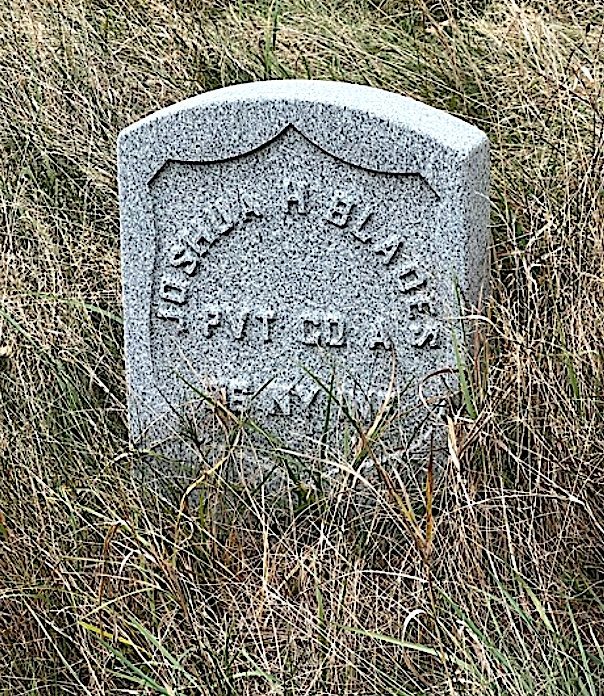
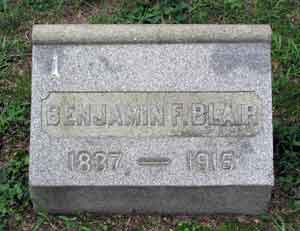
BLAIR, BENJAMIN F. (1837-1915). Captain, 123rd Ohio Infantry, Companies B and K. Born in Constantine, Michigan, he was a graduate of the University of Michigan at Ann Arbor, class of 1861. Blair was a member of Alpha Delta Phi while in college. Described as 5’7″ tall with a ruddy complexion, and giving his occupation as law student, Blair enlisted as a private on August 18, 1862, and mustered into Company B of the 123rd Ohio Infantry on October 16. On June 15, 1862, he became a prisoner of war in Winchester, Virginia.
Blair was captured with his colonel, William Tecumseh Wilson. In Wilson’s letter of November 1, 1863, the colonel described imprisonment at the notorious Libby:
About 1,000 of us are confined to seven rooms in which we cook, wash, eat, sleep, and do everything else, not being permitted to go outside the door for any purpose. The building is full of vermin and a portion of each day is devoted to skirmishing, as we call it, but which vulgar people would probably term “hunting lice.” We’re an interesting looking set of pets when this part of the daily labor is performed . . . . Most of our time is spent in reading when matter can be had, playing cards, checkers, chess, fighting our battles over, and talking about the loved ones at home, that is, when not engaged in cooking or washing clothes. It is very monotonous, and as one of my companions frequently remarks, “a hard way of serving the Lord,” but the proud consciousness that we are suffering all this for our country enables us to bear it with comparative cheerfulness.
His obituary in the New York Evening Post notes that he was held at Libby Prison, in Richmond, Virginia, from which he escaped and rejoined his regiment. Lieutenant Hiram Luther Sibley, of the 116th Ohio Infantry, Company B, was imprisoned with Blair at Libby. On January 11, 1864, Sibley wrote in his diary: “Warmer night and pleasanter day. Commenced 2nd Volume of “Phillips’ Evidence,” for second reading today. Read 49 pages with my valued, highly esteemed, educated, and talented friend, Adj. B. F. Blair of 123rd OVI. I regard it as both a privilege and pleasure to study with such a friend.”
Blair moved through the ranks from sergeant major (1862-1863), to first lieutenant (1863-1865), to captain on May 27, 1865, effective upon his transfer to Company K on that date. He mustered out on June 20, 1865.
According to his obituary in the New York Evening Post, which confirms his military service, Blair came to New York after the Civil War, resumed his study of law and started his law practice there. For forty-seven years, he was a senior partner in the firm of Blair & Rudd. As per the 1868 Brooklyn Directory, the 1870-1873 New York City Directory and the 1877 New York City Directory, Blair was a lawyer in Manhattan who lived at 19 Third Avenue in Brooklyn. The Brooklyn Directory for 1885-1886 noted that he was a lawyer at 102 Broadway in Manhattan and lived in Pearl River, New York; the New York City Directory for 1890-1892 listed him as a lawyer at the same Broadway address who lived at 195 Greene Avenue in Brooklyn.
On January 30, 1906, the Brooklyn Daily Eagle reported that Blair, a renowned lawyer, was scheduled to lecture at the Young Men’s Club of Plymouth Church on his “Experiences in Libby and Other Southern Prisons.” He had previously lectured at the church two years earlier on his “Escape from Libby Prison.” A longtime member of the Plymouth Church, he was a deacon there and held other positions. His obituary in the New York Evening Post notes that he was an intimate friend of the Reverend Henry War Beecher (see).
Active in Brooklyn politics, he was at one time chairman of the Kings County Republican Committee. As per an article in the New York Tribune, dated January-February 1893, Blair was a member of a committee of Republicans who sought to improve Republican electoral performances in New York City. That committee traveled to Philadelphia to see how the Republican organization there was successful in winning control of that city’s elected offices. The new plan to broaden voter representation in Brooklyn was to reorganize and form election district associations and ultimately send delegates to a central campaign committee. That article also states that Blair was one of the counsels who challenged Democrats gerrymandering of Assembly districts in Brooklyn. The biography of Blair in the aforementioned article confirms his Civil War service and notes that he lived at 195 Greene Avenue in Brooklyn.
Retaining his interest in military matters, Blair was a member of the Ulysses S. Grant Post #327 of the G.A.R. In 1907, he received a pension under certificate 1,140,523. He was also a member of the Union League Club. As per an obituary notice in the New York Tribune, members of the Military Order of the Loyal Legion, a patriotic association of Civil War officers of which he was a member, were invited to attend his funeral. He last lived at 246 Washington Street, Glen Ridge, New Jersey. His widow, Mary Louise Blair, who is interred with him, applied for and received a pension in 1915, certificate 797,945. Section 172, lot 20670.
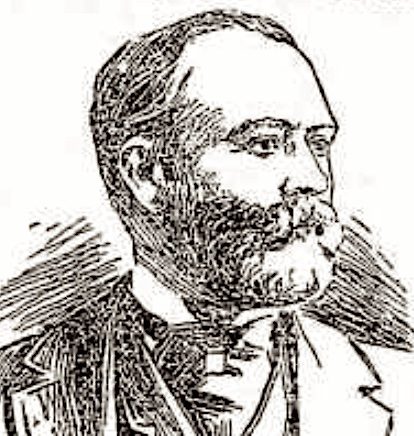
BLAIR, CHARLES DAVID (1840-1920). First lieutenant, 12th Regiment, New York State Militia, Company F. After he enlisted as a private at New York City, his birthplace, on April 19, 1861, he mustered into the 12th Regiment on May 2, and mustered out at New York City on August 5, 1861. When his regiment was reactivated a year later as part of the New York State National Guard, he was promoted to second lieutenant on May 31, 1862, commissioned in on that date, and mustered out at New York City on October 8, 1862. When the 12th was reactivated for 30 days in 1863, Blair was promoted to first lieutenant and commissioned into his company on July 3, and mustered out at New York City on July 20.
After the Civil War, Blair was apparently promoted to captain of Company K of the 12th but was removed from military service due to incompetence in 1866. In 1904, his application for an invalid pension was granted, certificate 1,096,240. His last residence was at 36 Netherwood Terrace in East Orange, New Jersey. He died from pneumonia. Mary Blair’s application for a widow’s pension was granted, certificate 893,907. Section 197, lot 28914.
BLAIR, DeWITT CLINTON (1833-1915). Private, 22nd Regiment, New York State National Guard, Company G. Born in Warren County, New Jersey, Blair was a lawyer living in Blairstown, New Jersey, according to the 1860 census. He was 5′ 9″ tall with a high forehead, round chin, scar over his right eyebrow, dark brown hair and brown eyes. He enlisted in 1862 at New York City as a private and served with the 22nd Regiment for three months mustering out at the expiration of his enlistment. He was living in Manhattan as per the 1900 census. His last residence was 6 East 61st Street in Manhattan. Blair died from pneumonia. Section 79, lot 1756.
BLAKE, THOMAS H. (or GEORGE J.) (1843-1903). Private, 10th New York Infantry, Company H. After enlisting as a private using the alias George Blake at New York City on April 26, 1861, he mustered into the 10th New York on April 30, and mustered out on April 26, 1863, at Camp Suffolk, Virginia. In 1902, his pension application was granted, certificate 1,050,629. He last lived at 269 Manhattan Avenue in Brooklyn. His death was attributed to heart disease. His wife’s application for a widow’s pension was granted under certificate 571,649. Section 168, lot 16439, grave 4.
BLAKEMORE, WILLIAM FREDERIC (1843-1910). Acting third assistant engineer, United States Revenue Cutter Service. Blakemore, who was born in New York, enlisted in the United States Revenue Cutter Service on May 14, 1864, as an acting third assistant engineer. At that time, he was 5′ 8½” tall with a ruddy complexion, brown eyes and black hair. His assignment was on board the USS Shamrock. He was honorably discharged on October 16, 1865.
Continuing his military career after the Civil War, Blakemore re-enlisted as a third assistant engineer in August 1866, was promoted to assistant engineer on August 27, served on the USS Mohican and USS Mohongo and rose to captain at some point before he mustered out on November 17, 1868. In October 1872, he returned to the Revenue Cutter Service and was a chief engineer at the time he applied for an invalid pension. His pension application indicated that his hair was turning gray and that he weighed 190 pounds. In 1907, he received a pension, certificate 38,701. At the time of his death from nephritis, he resided at 522 60th Street in Brooklyn. Section 136, lot 32697, grave 2.
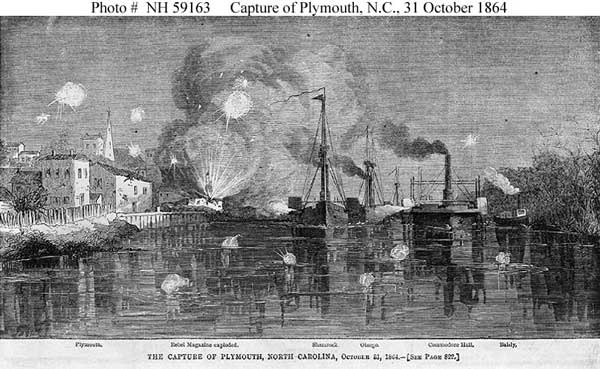
BLANCHARD, JAMES R. (1843-1917) Second lieutenant, 3rd New York Infantry, Company I; private, 9th New York Infantry, Company I. James R. Blanchard was born in 1843 to John, a tobacconist and Mary Blanchard, and grew up in New York. Prior to his service in the Civil War, he worked as a stevedore and clerk; at enlistment stood 5′ 8″ tall with black hair and gray eyes.
James enlisted as a private in the 9th New York Infantry, Hawkins’ Zouaves, on August 22, 1862, for a period of three years. On May 6, 1863, he was transferred to the 3rd New York Infantry. He earned two promotions, rising to corporal on July 1, 1863, and later sergeant on July 29, 1864. On April 25, 1865, he was promoted to second lieutenant. In this rank James would have been responsible for the well- being, training and discipline of his c, but did not muster in.
Discharged from the military on June 17, 1865, James worked as a tailor, leather worker and book binder. In 1880, he married Marion Adams and became a step-father to five-year-old Georgina.
By 1900, James, Marion and Georgina had relocated to Newark, New Jersey; by 1910 they returned to New York City, then settled in Roselle Park, New Jersey, where James would die from influenza (listed as “La Grippe” in Green-Wood’s burial records) on January 20, 1917. Section 136, lot 28307.
BLANEY, ARTHUR (1840-1881). First sergeant, 83rd New York Infantry, Company I. Born in Ireland, Blaney enlisted as a private at New York City on June 17, 1861, and mustered into the 83rd New York on August 2. On or about August 15, 1861, he was promoted to corporal, then became a sergeant on or about April 15, 1863. He rose to first sergeant on October 3, 1863, and transferred into the 97th New York on June 7, 1864. His tombstone notes that he was a captain in the 9th Regiment of the New York State National Guard but that service might have been after the War.
In 1880, Blaney applied for and received an invalid pension, certificate 505,807. Most likely, he and John Blaney (see) were brothers. He died from tuberculosis at St. Francis Hospital in New York. His wife applied for a widow’s pension in 1891, application 482,840, but there is no certificate number. Section 203, lot 22948.
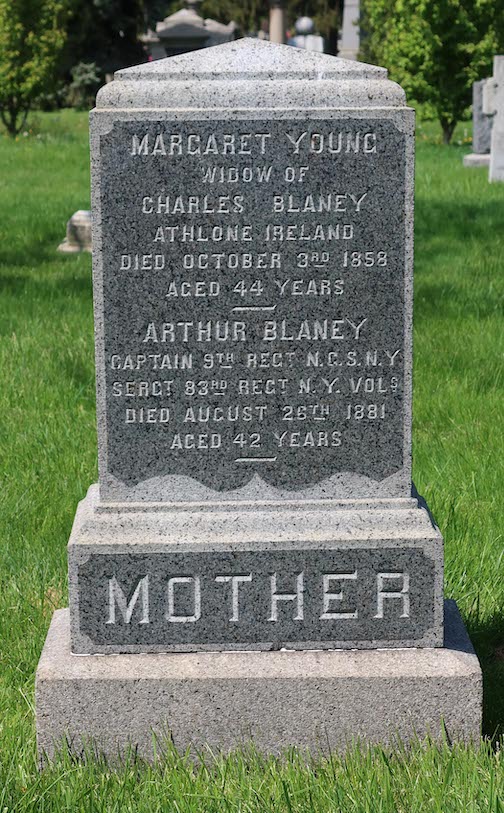
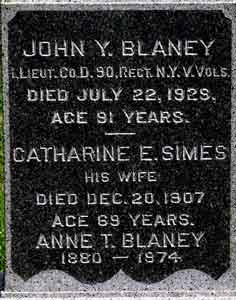
BLANEY, JOHN Y. (1838-1929). First lieutenant, 90th New York Infantry, Companies C and D. Born in Ireland, he enlisted as a private at New York City on September 24, 1861, and mustered into Company C of the 90th New York on October 11. Blaney rose through the ranks and was promoted to corporal and sergeant on unknown dates. He re-enlisted on February 20, 1864, was promoted to second lieutenant on December 2 of that year and to first lieutenant the next day effective upon his transfer to Company D on December 9.
In 1890, Blaney applied for and received an invalid pension, certificate 492,455. Most likely, he was the brother of Arthur Blaney (see). He last lived at 1209 Bushwick Avenue in Brooklyn where he died from senility at age 91. Section 203, lot 22948.
BLANGEY (or BLANCHARD), NELSON (1841-1905). Corporal, 133rd New York Infantry, Company A. Blangey, who was borne on the rolls as Nelson Blanchard, was born in Albany, New York. A clerk at the time of his enlistment, he was 5′ 7½” tall with hazel eyes, brown hair and a light complexion. He enlisted at New York City as a private on August 18, 1862, and mustered into the 133rd New York on September 24. According to his muster roll, he was detained at City Point, Virginia, in 1861, and ordered to rejoin his regiment; he was also listed as absent in October 1861. He was wounded in action at the Battle of Port Hudson, Louisiana, on June 14, 1863. On June 6, 1865, he mustered out with his company at Washington, D.C.
In 1875, Blangey applied for an invalid pension, application 205,727, but there is no certificate number. He last lived at 226 West Street in Hoboken, New Jersey. His death was attributed to gastritis. Esther Blangey applied for and received a widow’s pension in 1915, certificate 602,011. Section D, lot 18513, grave 26.
BLANK, FRANZ F. (1839-1879). Private, 45th New York Infantry, Company B. Originally from Germany, Blank enlisted at New York City as a private on September 6, 1861, and mustered into the 45th New York three days later. According to his military record, he deserted from his unit at Centreville, Virginia, on October 6, 1862, was arrested at New York City on April 14, 1863, and was confined at Fort Columbus, New York Harbor, on January 14, 1864. His last residence was 234 West 35th Street in Manhattan. Blank’s death was attributed to Bright’s disease. Section 126, lot 14679, grave 11.
BLEAKLEY, WILLIAM P. (1842-1875). Private, 10th New York Infantry, Company A. After Bleakley enlisted at New York City on April 26, 1861, he mustered into the 10th New York the next day, and mustered out on May 6, 1863, at New York City. He last lived in Brooklyn on 86th Street in the New Utrecht neighborhood. His death by pistol shot was a suicide. Section 2, lot 5832.
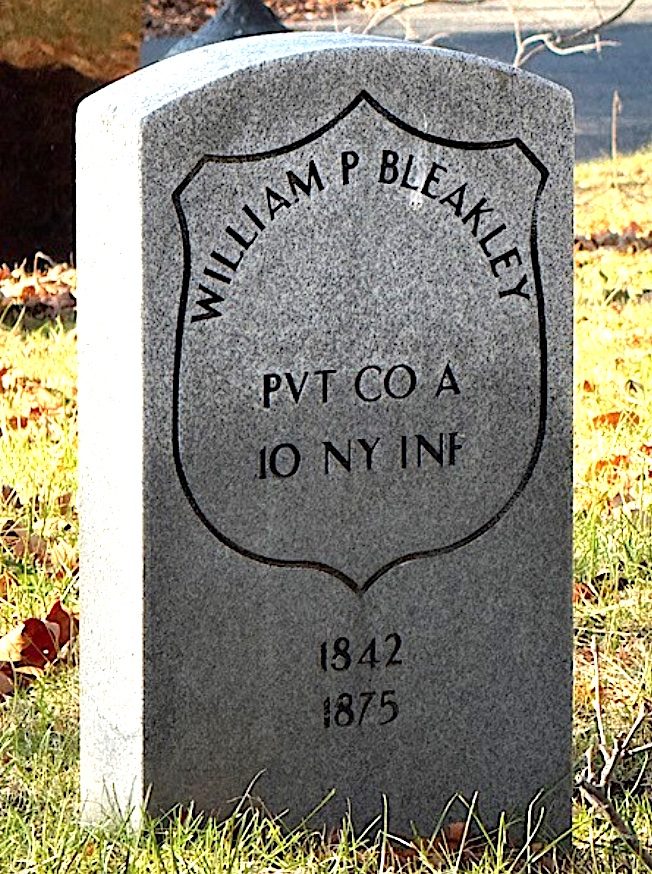
BLIGH, ROBERT WATT (1836-1922).Newspaperman. The year of Bligh’s birth is uncertain. Both the Find A Grave website and his obituary in the Evening World indicate his birth in April 1836 to Thomas and Mary Anne Murray Bligh. However, a feature article in the Brooklyn Daily Eagle in April 1922 indicates that he was 88 that year which would indicate that he was born in 1834. The birth year is further complicated by his family tree on the Ancestry website which shows a birth date of May 9, 1833. Find A Grave and Ancestry report that Bligh was born in Ireland, specifically in Cavan. The Ancestry website reports that he arrived in Philadelphia in 1852 and then relocated to New York City in 1855; some obituaries report the year he came to the United States was 1851.
Robert’s name was on the manifest of the Waredall, arriving in New York from Guayanilla, Puerto Rico, on May 10, 1855. As per his online family genealogy, he married Delia Adelia Misset on November 28, 1855, in New York City. The couple had eight children. Their marriage is recorded in the United States records of the United Methodist Church; that record states Robert’s age as 22 with a birth year circa 1833.
In 1859, he joined the New York Herald as a reporter and then, after two years there, organized and ran the paper’s Index Department. The 1860 census, which indicates that he was a merchant, shows him living in Brooklyn with his wife and two-year-old son, Robert, and one-year-old son, John. Two others, with the surname Grace, relationship unknown, lived in the household.
As per his obituary in the Evening World, Bligh was in charge of the Index Bureau of the New York Herald for forty years. In 1860, he covered the arrival of the Great Eastern, a massive iron-clad ship, when it arrived from England, to much fanfare, on June 28, 1860. His Brooklyn Daily Eagle obituary reports that, during the Civil War, he rode with Major Robert Anderson and Lieutenant Abner Doubleday, the defenders of Fort Sumter, on their arrival at the Battery after the surrender of the fort. Numerous obituaries report that he carried the news of the USS Monitor’s victory over the CSS Merrimac (also called the CSS Virginia) to John Ericcson, the engineer who designed the Union’s first ironclad, nicknamed the “Yankee Cheesebox.” Ericcson’s work on the Monitor revolutionized Naval warfare.
Ancestry reports that he became a naturalized citizen on September 18, 1865. His document of naturalization includes his oath of allegiance and states that he came to the United States before he was 18 and that he was over the age of 21 at time of naturalization. At the time of the 1865 New York State census, he and Adelia (Delia) were living in Brooklyn with four sons: Robert, John, Charles and Edward; two others lived with them. The 1870 census records that the couple had two more children, Frederic and Meta Maty, and that Robert was an editor. By 1880, the couple lived at 108 2nd Street in Brooklyn and Robert was now a government clerk. There were five children in the household: John, Edward, Frederick, Meta and Ethel (age 2). Thomas Bligh, born in 1881, is not listed on the census and no death date is given for him on Ancestry’s page.
During his time as a newspaperman, the Brooklyn Daily Eagle reported in 1922 that Bligh was on the committee that welcomed reporter Henry M. Stanley after he returned from Africa following his successful search for Dr. Livingstone in 1871. In that same article, Bligh recalled that the London Times sent their reporter, George W. Russell, to the United States in 1861. Bligh was seated opposite Russell at a dinner in which Russell spoke of the Civil War and his remark, “I fear the great Republic is gone,” was met with near pandemonium. Russell later wrote about the Battle of Bull Run, an article reprinted in some New York papers. Bligh’s Brooklyn Daily Eagle obituary noted that Robert ran the Weekly Herald from 1872 to 1876, was the paper’s librarian from 1870-1874, and compiled its Almanac from 1872 to 1878. His New York Times obituary detailed that Bligh was at the blessing for the building of St. Patrick’s Cathedral.
After his career with the Herald, Bligh worked for the custom service in the weigher department for fifteen years, three years of which he was acting chief clerk. The 1892 New York State census states that he was a clerk living at 612 Carroll Street in Brooklyn, 57-years-old and a citizen. Bligh appeared on the passenger manifest of the Oceanic having departed from Queenstown, Ireland, and arriving in New York City on July 23, 1908; he is listed as married, living in Brooklyn and age 74.
Bligh last lived at 407 East 4th Street in Brooklyn. He died at the home of his daughter, Mrs. W. H. Russell, in Haworth, New Jersey. Green-Wood’s chronological books note his date of death as December 26, 1922, and his age as 83 years and eight months, different from other documents; his death was attributable to chronic endocarditis. His funeral took place at All Saints Church in Brooklyn. The Brooklyn Daily Eagle reported that he was survived by several children. Section 122, lot 15905.
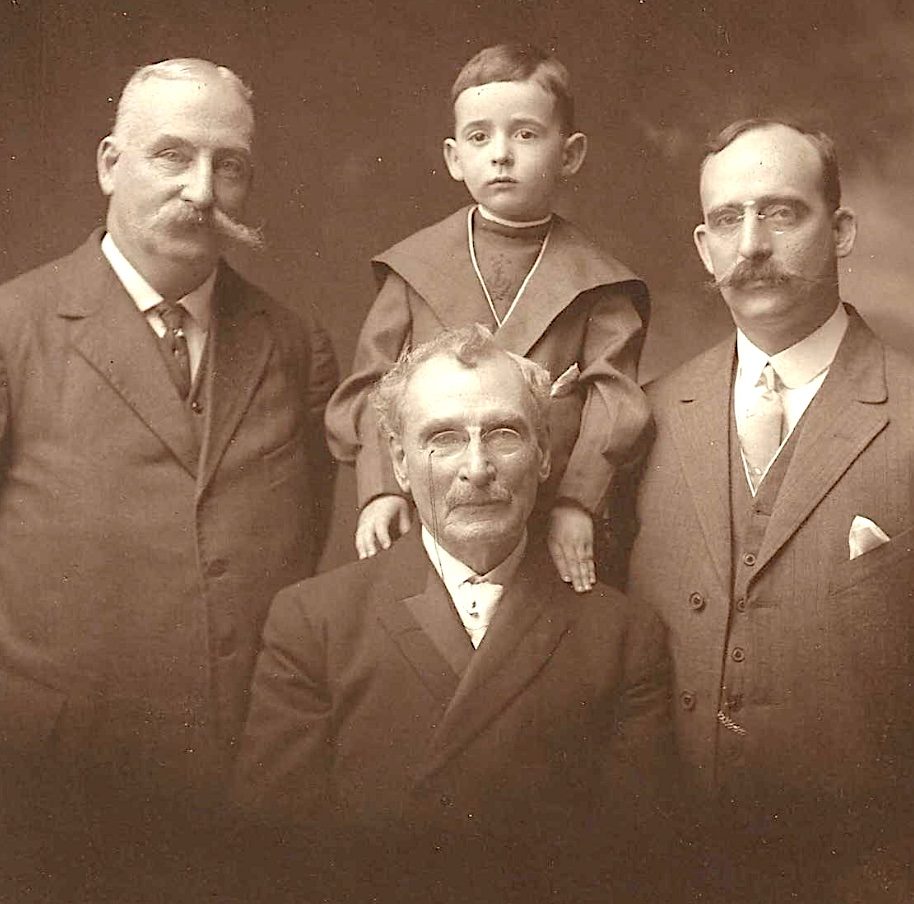
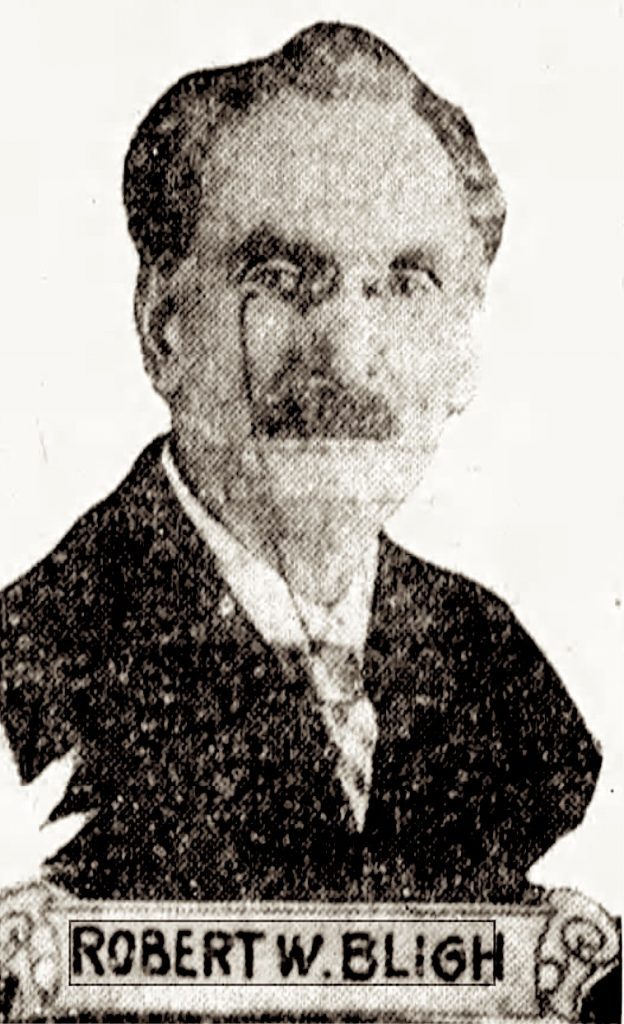
BLISS, ELIPHALET WILLIAMS (1836-1903). Corporal, 3rd Connecticut Volunteers, Company I. Born in Fly Creek, New York, he grew up on a farm there, worked in a machine shop nearby, then went to work in the Parker Gun Factory in Meriden, Connecticut, rising to the position of foreman. He was a corporal in Company I of the 3rd Connecticut Volunteers during the Civil War; an older brother was a major in the Confederate Army.
On June 19, 1865, Bliss married Anna Elizabeth Metcalf; the couple had one daughter. He moved to Brooklyn in 1866, and the next year he established the machine shops which were to become E. W. Bliss Company and the United States Projectile Company, together employing 1,300 workers by the time of his death. He is listed as a machinist in the Brooklyn Directory for 1870-1873; at that time, he lived at 258 Adelphi Street. By 1884, his plant, on the Sunset Park waterfront, was the world’s largest factory. The company named for him manufactured tools, presses, and dies for use with sheet metal, as well as the Whitehead torpedo; the other made most of the shells for the large guns of the United States Navy. He obtained numerous patents, including those for machines to make and solder cans and to shape and cast sheet metal. His factory supplied material for construction of the Brooklyn Bridge.
Bliss played an important role in the development of Brooklyn. He had large real estate holdings, was vice president of the Brooklyn Heights Railroad and the Brooklyn Gas Fixture Company and was a director of the Kings County Trust Company. His estate, Owl’s Head on the heights of Bay Ridge at First Avenue and 67th Street, had an observatory that looked out on New York Harbor, and was one of the great private homes of Brooklyn. Active in many New York and Brooklyn clubs, he was a member of five leading yacht clubs. He was also a member of G.A.R., Lafayette Post #140. A founding member of the Peary Arctic Club in 1898 to fund explorations of the Arctic, Robert Peary later named Bliss Bay in Greenland after him. He died of angina at his Owl’s Head residence. Section 175, lot 31479.

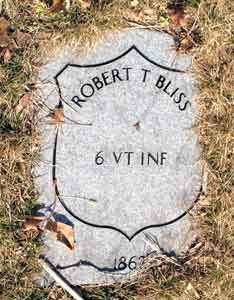
BLISS (or BLIGH), ROBERT T. (?-1862). Unknown soldier history. On July 14, 1862, he died at the College Hospital in Brooklyn of typhoid fever. Further details of his service are unknown. Section 115, lot 13536 (Soldiers’ Lot), grave 77.
BLISS, WALTER J. (1843-1888). Private, 25th Connecticut Infantry, Company K. A Vermont native and resident of East Hartford, Connecticut, Bliss enlisted as a private on August 21, 1862, and mustered into the 25th Connecticut on November 11. He mustered out at Hartford on August 26, 1863. He last lived at 363 Seventh Avenue in New York City. In 1890, his wife applied for and received a widow’s pension, certificate 384,970. Section 6, lot 20118, grave 809.
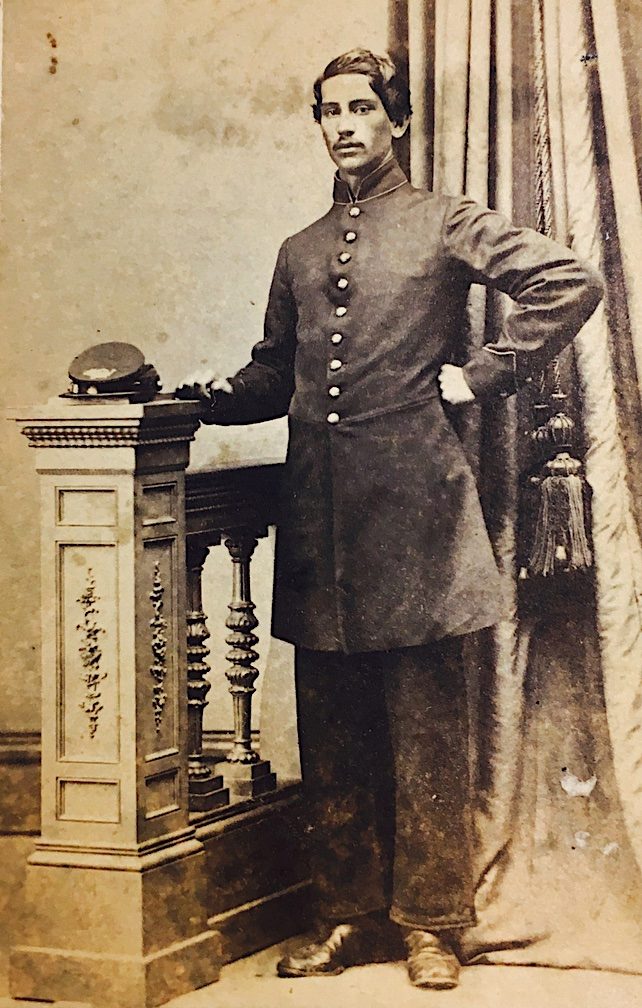

BLISS, WILLIAM WARWICK (1839-1887). Lieutenant colonel, 87th United States Colored Troops (USCT); 84th United States Colored Troops (USCT); captain, 95th United States Colored Troops (USCT); sergeant major, 176th New York Infantry, Company B. A native of New York, Bliss enlisted as a private at Brooklyn on September 11, 1862, mustered into the 176th New York on December 18 of that year, and was promoted to sergeant major on March 1, 1863, at which time he transferred to the Field and Staff. On June 23, 1863, he was taken as a prisoner of war at Brashear City, Louisiana, and was returned on August 17, 1863.
On September 11, 1863, Bliss was discharged for promotion to captain at Bonnet Carre, Louisiana, and mustered into the 95th USCT on October 5. On November 26, 1864, he transferred into the 87th USCT (new) and was appointed its lieutenant colonel on December 1. He transferred into the 84th USCT with that same rank on January 14, 1865, and was discharged on September 7, 1865. His name is displayed on the African American Civil War Memorial in Washington, D.C., plaque C-90. Bliss last lived at 452 5th Street in Brooklyn. His death was caused by hemorrhage of the lungs. Section 83, lot 18892.
BLOCK, JOHN WILLIAM (1842-1912). Rank unknown, Confederate States of America. Block was born in Cape Girardeau, Missouri. His father owned the St. Charles Hotel there and his mother, Matilda Dodeney Block, traced her lineage to pioneers of that town. He was known familiarly as “John Will” Block. According to his obituary of April 1, 1912, in his hometown’s The Daily Republican, he served in the Civil War as a Confederate soldier.
His obituary notes that after the Civil War, Block relocated to New York City where he entered the diamond business on Maiden Lane and acquired a considerable fortune. He is listed as a jeweler on Nassau Street in the New York City Directory for 1875-1876. The census of 1880 notes that he lived at 376 State Street in Brooklyn, was married to Mary Louise, and had two toddlers. At the time of the 1900 census, he lived at 321 Eastern Parkway, was married to May French as of 1891, and was employed as a diamond merchant. The census of 1910 notes that he was married 18 years, lived on West 97th Street in Manhattan, and was a jeweler.
Block last lived at 305 West 97th Street in Manhattan. His death certificate indicates that he was married and a diamond merchant. His Missouri obituary reports that he was survived by two sisters in his hometown, which he visited in 1907, and a brother, who lived in New York. Block’s death was also announced in the New York Herald with a request for Cape Girardeau’s papers to print news of his passing. His online family tree shows that he had five children with his first wife, three of whom survived him, and one child with his second wife. Section 184, lot 25509.
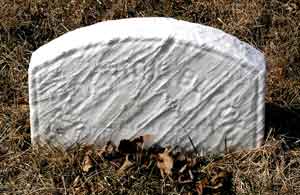
BLOCKE (or BLACK), FREDERICK (1840-1884). Rank unknown, United States Navy. Originally from Germany, he enlisted in the United States Navy on April 4, 1862, and served until his discharge on March 4, 1865. He was a member of the Grand Army of the Republic (G.A.R.) in Brooklyn from March 27, 1877. He died from tuberculosis. His last residence was 17 Garfield Place in Brooklyn. Section 127, lot 17931, grave 436.
BLODGETT, WILLIAM H. (1841-1916). Private, 53rd New York Infantry, Company I; 132nd New York Infantry, Company G. A Brooklyn native, he enlisted on July 8, 1862, at Suspension Bridge, New York, and served in the 53rd New York. He was transferred into the 132nd New York on September 13, 1862, and mustered out on June 29, 1865, at Salisbury, North Carolina. His last address was 1060 Amsterdam Avenue in Manhattan. Blodgett died from heart disease. Section 127, lot 16311, grave 178.
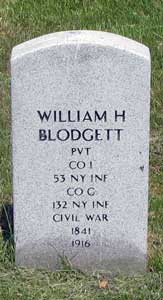
BLOOD, GEORGE W. (1837-1896). Corporal, 3rd Missouri United States Reserve Infantry, Company E. Blood was a resident of St. Louis, Missouri, when he enlisted as a private and mustered into the 3rd Missouri Reserve Infantry on May 8, 1861. He mustered out as a corporal at St. Louis on August 18, 1861. The St. Louis Directory for 1864 reports that he was employed as a clerk and the 1866 St. Louis Directory lists him as an auditor. According to the 1895 St. Louis Directory, he was working as a superintendent. He was the brother of James Harvey Blood (see). He last lived at 936 Tremont Avenue in the Bronx. As per his obituary in the New York Herald, newspapers in Chicago and St. Louis were asked to print notices of his death. Section 193, lot 25770.
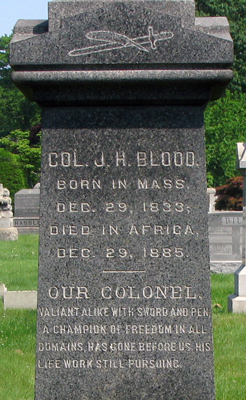
BLOOD, JAMES HARVEY (1833-1885). Colonel, 6th Missouri Infantry. Blood, who was born in Dudley, Massachusetts, was the brother of George Blood (see). He married his first wife, Mary Ann Clapp Harrington, on October 5, 1855; the couple had one child. During the Civil War, James Blood organized the 6th Missouri Infantry in May and June 1861, and mustered in as its lieutenant colonel. He was 5′ 8″ tall with a long, straight nose, dark brown beard and deep blue eyes. In May 1862, the 6th Missouri left the state when they were ordered to Corinth, Mississippi, to join the 2nd Division of Major General William Tecumseh Sherman’s 15th Army Corps; the 6th throughout its reorganizations remained with Sherman during the entire course of the Civil War.
On March 29, 1862, Brigadier General James Totten, United States Army, cited Blood for his “energy and decision” in his field report from Jefferson City, Missouri, describing a skirmish on March 25-28 where Blood led an expedition into the upper part of Moniteau County, Missouri. Totten noted, “Colonel Blood being in the advance, ordered the advance guard to charge, at which the rebels ran for the brush and as our men approached, fired.” On December 22, 1862, Blood was promoted to colonel. In support of the promotion, Sherman said of Blood: “Lieutenant Col. Blood is entitled to promotion by long and gallant service to make his regiment what it now is. To withhold from him his well merited promotion would be an act of injustice.” A week later, he was wounded in the breast by a spent ball at the Battle of Chicksaw Bayou, and, despite the injury and with the assistance of two men, managed to remain in command of his troops.
As per the Missouri Democrat on January 3, 1863, Sherman said that the actions of the 6th Missouri “deserved to be immortalized.” Blood and the 6th were engaged in the battles leading up to the Siege of Vicksburg and the Chattanooga campaign; in July and August of 1863, Blood was in temporary command of the First Brigade when he was wounded; he was considered by Sherman to be one of his best and most reliable officers. Blood resigned on April 2, 1864, saying that “I therefore believe the interest of the service will be consulted by the regiments returning to the field under an officer who will remain in it during the war. Besides the present strength of the regiment under existing laws does not entitle it to a colonel.”
He returned to St. Louis where he was city auditor and president of a street railroad. During General Price’s raid in St. Louis in the fall of 1864, Blood organized a militia. In 1865, he was divorced and married his second wife, Victoria Woodhull, the famous suffragist, women’s rights advocate and first woman to run for president (in 1872). The couple left St. Louis after the marriage, at which time he resigned from his positions in that city. The couple and Victoria’s sister, Tennie Claflin were jailed for obscenity after publishing an article in their weekly in 1872, which exposed the affair of the Reverend Henry Ward Beecher (see) and one of his parishioners, Elizabeth Tilton; subsequently, the jury in Beecher’s trial in 1875 reached no decision. An article in The New York Times stated that he consulted Woodhull, a spiritualist who divined them to marry; the couple divorced in 1876. Blood’s marriage to Woodhull was particularly scandalous in that Dr. C. H. Woodhull, Victoria’s ex-husband, lived with them; the couple considered his presence an act of charity because he was an alcoholic who was financially unable to support himself but when sober, provided free medical care to them and his two children.
In 1882, his application for an invalid pension was approved, certificate 310,015. On August 18, 1885, Blood married Isabella Morrill in Jersey City, New Jersey. He died under uncertain circumstances from heart disease or jungle fever in Akantin, Gold Coast (present day Ghana), in West Africa, where he superintended a gold mine and had struck gold. In 1887, his body was returned to the United States for burial. Isabelle Blood, his third wife of four months who is interred with him, applied for and received a widow’s pension in 1887, certificate 241,507. A memorial to the 6th Missouri, of which Blood was its colonel, is located on Union Avenue in Vicksburg National Military Park. Section 193, lot 25770.
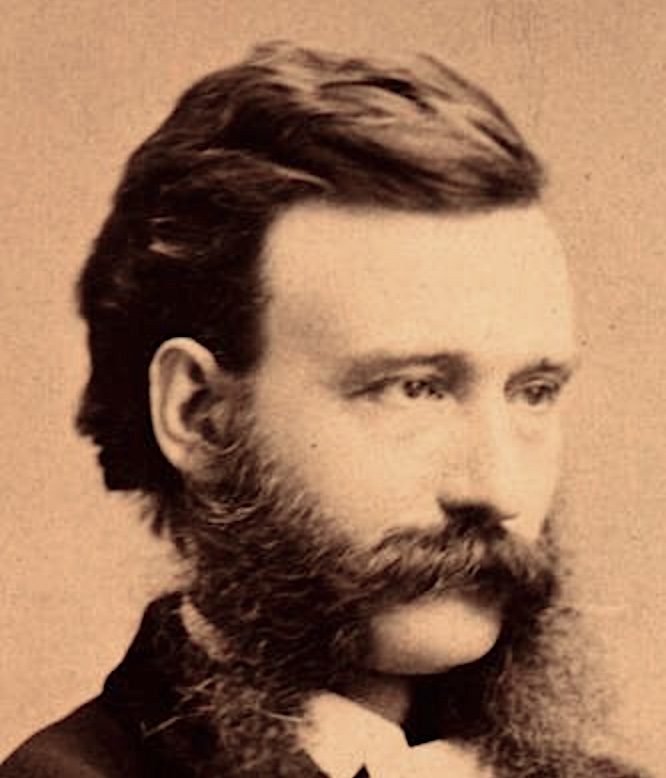
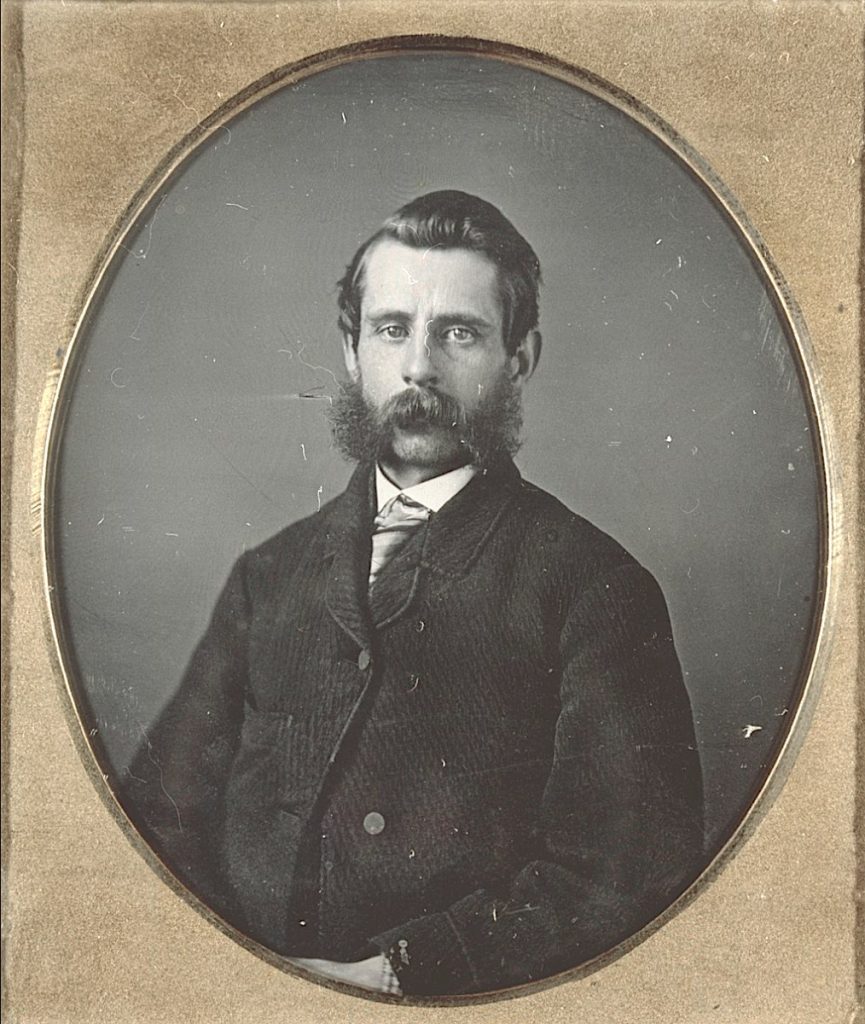
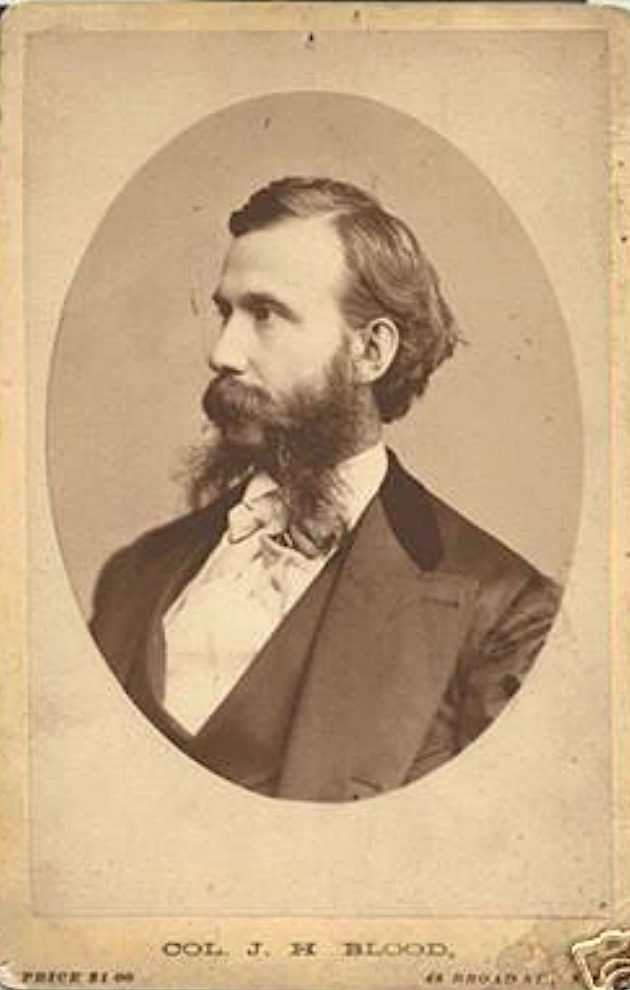
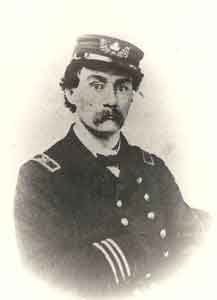
BLOODGOOD, DELAVAN (1831-1902). Surgeon, United States Navy. Born in Springville, New York, he graduated from Colgate University (formerly Madison University), and Jefferson Medical College in Philadelphia. Bloodgood married Jennie Ruger in 1857; the couple had one daughter. He entered the Navy as an assistant surgeon on March 13, 1857, and was attached to the Merrimack in the Pacific Squadron from 1858-60. During the Civil War, he served on the Mohawk in 1861, was commissioned as surgeon on January 24, 1862, and was in the West India Squadron in 1862 aboard the Dacotah. From 1863-64, Bloodgood remained aboard the Dacotah, a large steam-sloop, in the North Atlantic Blockading Squadron.
Subsequently, Bloodgood was on the steamer Michigan in the lakes from 1865-66. He continued his service on the New York, a receiving-ship, in 1867, moved to the North Pacific Squadron from 1867-68, and returned to the New York in 1869. The Brooklyn Directory for 1870-1873 lists him as a surgeon in the United States Navy; he then lived at 320 Clermont Avenue. He is also listed as a surgeon in the Brooklyn Directory for 1880-1882; his home address was on Flushing Avenue. At the time of his retirement from the Navy in 1893, he was a medical director. He subsequently served at the Naval Hospital in Brooklyn during the Spanish-American War. Dr. Bloodgood was active in numerous community organizations including the Holland Society and the Military Order of the Loyal Legion. He last lived at 320 Clermont Avenue in Brooklyn. He died from angina. Section 155, lot 29611, grave 4.
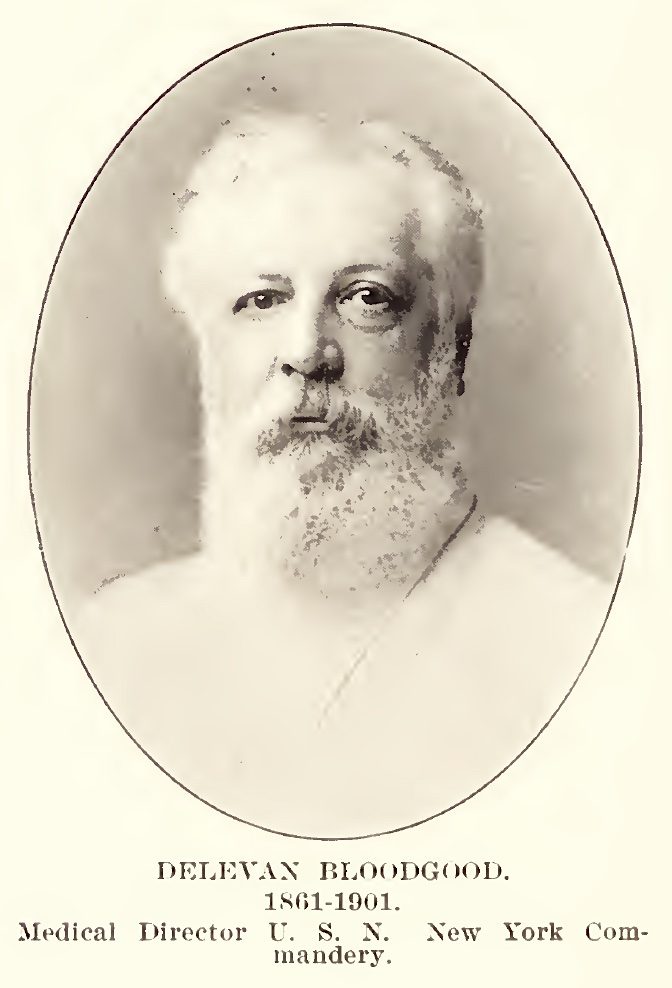
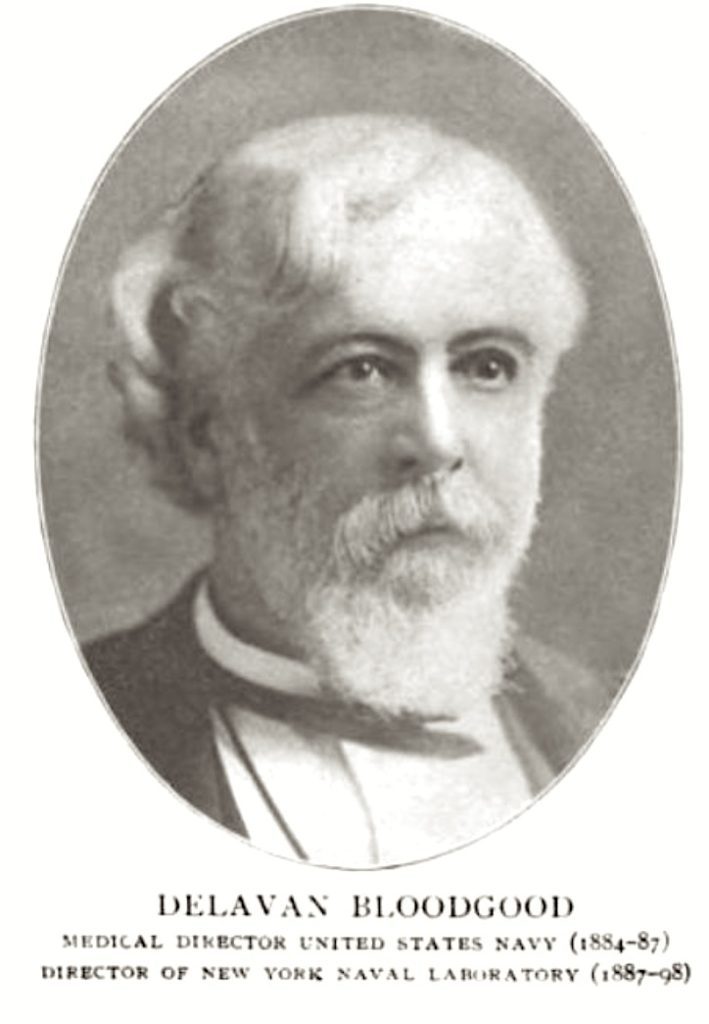
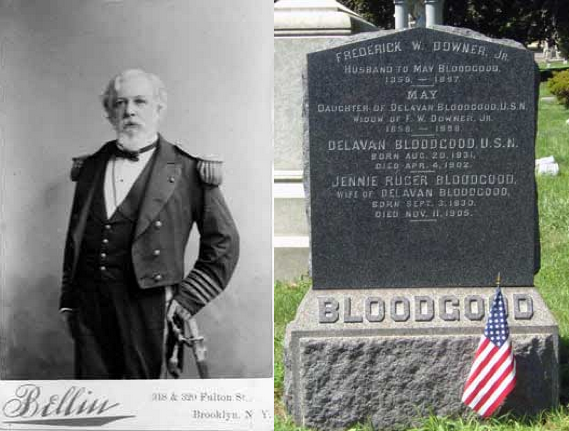
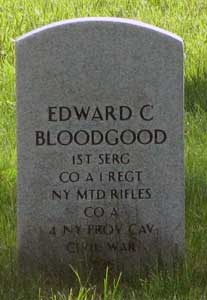
BLOODGOOD, EDWARD C. (1835-1891). First sergeant, 1st New York Mounted Rifles, Company A; 4th New York Provisional Cavalry, Company A. A native New Yorker, he enlisted there as a private on August 19, 1862, and mustered that day into the 1st New York Mounted Rifles. He rose to corporal on January 12, 1864, and to sergeant on July 30, 1864. After re-enlisting on September 1, 1864, he was promoted to first sergeant the next day, transferred to the 4th New York Provisional Cavalry two days later, and mustered out at City Point, Virginia, on November 29, 1865.
Bloodgood is listed as a clerk in the 1868 Brooklyn Directory. On September 20, 1884, he mustered into the G.A.R. The Brooklyn Directory for 1890-1892 lists him as a clerk; he then lived at 1139 Broadway. In 1891, he applied for and received an invalid pension, certificate 889,760. He last lived at 1139 Broadway in Brooklyn. His death was attributed to pneumonia. Mary Bloodgood applied for and received a widow’s pension in 1891, certificate 360,878. Section 11, lot 4623.

BLOOM, JAMES C. (1835-1908). First lieutenant, 47th Regiment, New York State National Guard, Company A. Bloom, a native New Yorker, enlisted as a second lieutenant at Brooklyn on May 27, 1862, was immediately commissioned into the 47th Regiment, and mustered out at Brooklyn after three months on September 1. On June 6, 1863, he re-entered the service, was commissioned into his same regiment and company on June 17, and promoted that day to first lieutenant. He mustered out at Brooklyn after 30 days on July 23.
In 1904, Bloom applied for and was granted an invalid pension, certificate 1,089,625. He died from a cerebral hemorrhage. His last residence was in Newton, Connecticut. As per his obituary in the Brooklyn Daily Eagle, his funeral service was held at the chapel at Green-Wood Cemetery; his death notice also appeared in the New York Herald. In 1908, Clara W. Bloom, who is interred with him, applied for and received a widow’s pension, certificate 666,485. Section 69, lot 2661, grave 5.
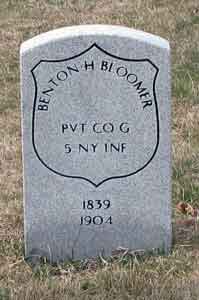
BLOOMER, BENTON H. (1839-1904). Private, 5th New York Infantry, Company G. Born in New York, Bloomer was a clerk who was 5′ 9″ with black eyes, dark hair and a dark complexion. He enlisted at New York City on April 25, 1861, and mustered into the 5th on May 9. A year later, he suffered from sunstroke, was hospitalized at White House Landing, Virginia, until June 10, 1862, and was discharged for disability on October 27, 1862, at New York City.
The censuses from 1870 and 1880 indicate that Bloomer was employed as a conductor of a horse carriage. In 1889, his application for an invalid pension was approved, certificate 862,782. According to the 1890 Veterans Census, he was living in Jersey City. His last address was 70 Clendenny Avenue in Jersey City, New Jersey. He died from endocarditis. Leah Bloomer’s application for a widow’s pension was granted in 1905, certificate 605,140. Section 117, lot 218.

BLOOMER, JOHN A. (1831-1869). First lieutenant, New York Marine Light Artillery, Company F. Bloomer was born in New York State. He enlisted as a first lieutenant at New York City on March 17, 1862, was commissioned in on April 15, 1862, and mustered out at Hilton Head, South Carolina, on April 18, 1863. He last lived in Cornwall, Connecticut. According to an inscription on his gravestone, he died “of disease contracted during the War of the Great Rebellion.” Section 29, lot 9050.
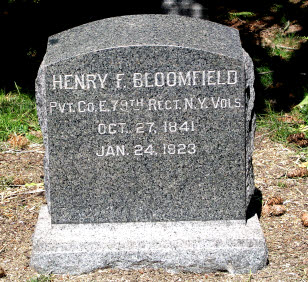
BLOOMFIELD, HENRY F. (1841-1923). Private, 79th New York Infantry, Company E. Born in New York City, he enlisted there as a private on May 13, 1861, mustered into the 79th on May 27, and mustered out after three years on May 31, 1864, at New York City. In 1873, Bloomfield’s application for an invalid pension was approved, certificate 124,034.
According to the 1880 census, he was a ship joiner, a trade akin to carpentry. The 1890 Veterans Schedule confirmed his military data and noted that he was shot in the breast during his service. His death caused by cancer, Bloomfield’s last residence was on Putnam Avenue in Brooklyn. On April 12, 1923, The New York Times reported that Bloomfield left his estate, valued at $12,000, to his daughter, Florence B. Morris, who is interred in the same lot. Section 190, lot 16047.
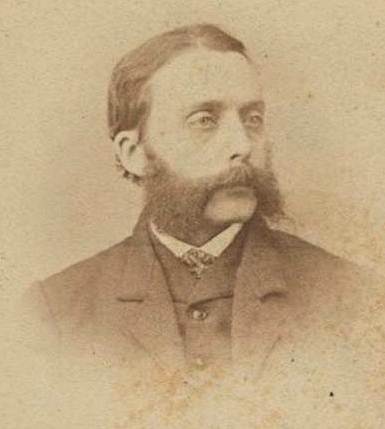
BLOOR, ALFRED JANSON (1829-1917). Assistant Secretary to the United States Sanitary Commission. Bloor was born in Edinburgh, Scotland. The New York State census of 1855 reports that he lived in Brooklyn with his brother, sister and aunt. An architect and fellow of the American Institute of Architects as of 1861, Bloor is listed as an architect in the New York City Directory for 1857-1862. He was an assistant secretary to the Sanitary Commission during the Civil War. The Sanitary Commission was established to improve the hygiene of camps and hospitals and tend to the emotional and health needs of soldiers and recruits. In his work for the Sanitary Commission, he drew up periodical reports, supplied information to affiliates, and supervised the Washington, D.C., supply depot. In Letters From the Army of the Potomac; Written During the Month of May, 1864, to Several of the Supply Correspondents of the U.S. Sanitary Commission (reprinted in 2010), he observed on May 4 as he ministered soldiers on a hospital boat near Belle Plain:
…But the giving of sustenance is not all the work. One man complains of his head being too low, and his overcoat has to be rolled up-or, failing that, the straw around him has to be gathered up-so as to form a pillow for him. (The pallets and bedding have given out, though the first boat loads sent off were as comfortably provided for as if in the wards of a general hospital, and the men we are tending are lying on the docks on straw; but this they count luxury after the battle-field and ambulance.) Another wants a handkerchief, and another a pair of socks. This man’s shirt is all torn and bloody, and must be replaced by another. One man complains of the intolerable heat, and some of his clothing must be removed; another is shivering with cold and more clothing, or an extra blanket must be provided for him. Here is one who feels the hand of death upon him, and the head of that one of our party who is tending him is bent down to catch from his white lips his last message to his friends…
On May 20, 1864, he visited Fredericksburg, Virginia, where he found all the buildings converted to hospitals, including a church:
…We are in one of the church hospitals, we will suppose. The pews are set two together, and the backs taken off where necessary, to form couches for the patients. The vestry is turned into an operating room. In one corner of the church is a good woman who has not quitted the half-delirious patient, whose brow she is now bathing with bay-water, for one hour in the last twenty. The altar is put to one side, and in its place two pews cradle a young boy who does not seem to be over fifteen years old. He was brought in, it was supposed, in a dying condition; but the good Samaritan, who is just directing to the Far West a letter he has written to the boy’s mother at his dictation, has, with the good things and better words, brought such a light into the boy’s eyes that he expresses the utmost confidence that he will be able to write to his mother himself the next day, and tell her that he safe from the effects of this wound, and ask her to pray that he may be spared in future battles, and rejoin her and his sisters and brothers in their happy Wisconsin home ‘when his time is out.’…
On May 24, he wrote that he had tried to get near the battle so as to better understand what the soldiers faced. Speaking of the sense of danger, he wrote:
The nearer I advanced the less I thought of it, except to reflect now and then that as long as I kept out of the range of the enemy’s musketry I was tolerably safe from musket shot, and the chances were many to one against my being hit by a cannonball or shell. But others did not seem to think so, for while I was still intent on observation a staff officer stepped out from a group surrounding a general and premising that, perhaps, as a civilian and unaccustomed to ‘this sort of thing,’ I was not aware of the general risk I was running, advised me to get back at least as far as a certain range he indicated…
On May 30, he wrote from Washington that he had ridden in a procession of ambulances to Port Royal on May 24, and then sat on the hay in an army wagon. After being jolted on the rickety road, Bloor stated that the dead were given a proper burial once camp was set up, and rations of coffee and crackers, although not good quality, were distributed. At Port Royal, a fleet from the Sanitary Commission arrived with fresh supplies and a campfire-lit where a woman labored to feed the hungry and wounded:
The clapboards from the whole of one side of the building had been torn down to light the fire that blazed on its wide hearth, and the ruddy gleam fell on the kind woman’s face that bent over the kettles that hung over it, and on the agents that assisted her or bustled about from barrel to box as they filled their pails, and on way-worn or wounded soldiers, who sat with their backs braced against the wall, and their legs-sometimes only one to a man-stretched out on the floor, while with heads thrown back they slept the blissful _ sleep of those who slumber not in wagons on the move; or eyed the preparations for supper with the happy consciousness that their turn for the good things would come in due time, and their patience be rewarded….
Bloor was clear in the final page of his report that those who sold food on hospital ships had no right to do; everything from the Sanitary Commission was supposed to be free. He was dismissed from his position in September 1864 after he failed to retract an accusation that others on the executive committee were working against him. Bloor also wrote Women’s Work in the Civil War in 1866 among various tracts and poetry. In 1871, he once again defended himself in a 45-page pamphlet against allegations of financial irregularities in his dealings with the Sanitary Commission.
Bloor is listed as an architect in the 1875-1876 and 1877 New York City Directories; at that time, he worked at 128 Broadway and lived at 138 Fifth Avenue. When the 1882-1883 New York City Directory was published, his office was at 335 Broadway and his home was at 241 West 14th Street. The 1891-1892 New York City Directory shows that he still worked from 335 Broadway; he then lived at 871 Lexington Avenue. One of the founders and life member of the Metropolitan Museum of Art in New York City, he designed many of the buildings in New York City, and belonged to many architectural and art societies where he served as the secretary of the American Institute of Artists and secretary of the New York chapter of the American Institute of Architects from 1867-1898. He also was a life member of the American Numismatic Society. He died of a cerebral hemorrhage in Stonington, Connecticut. Section 103, lot 13339.
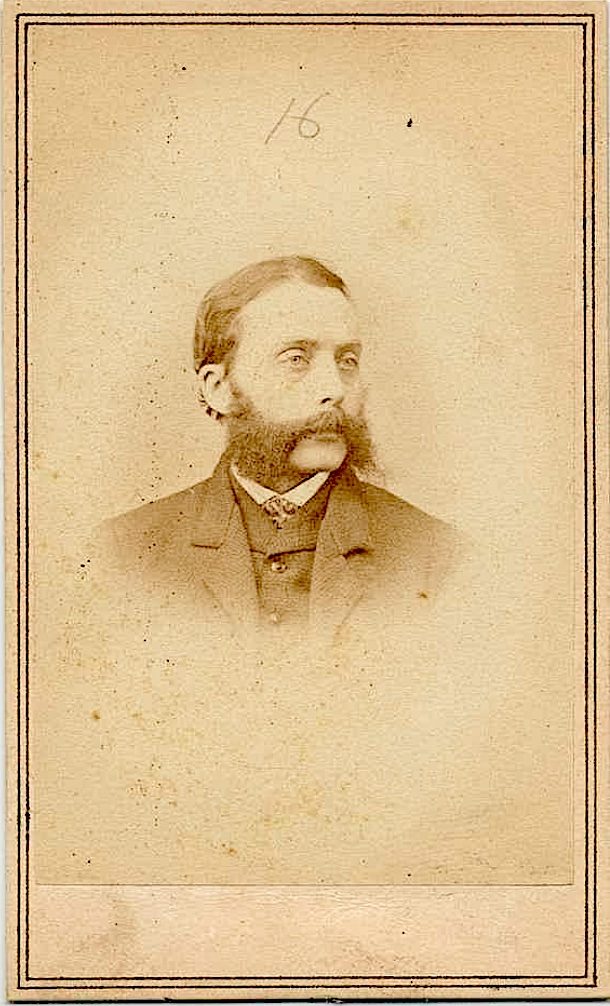
BLOSSFELD, WILLIAM (1831-1887). First lieutenant, 28th Regiment, New York State Militia, Company D. A German by birth, Blossfeld enlisted as a sergeant at Brooklyn on April 23, 1861, mustered into Company D of the 28th Regiment of the New York State Militia on May 11, was promoted to second lieutenant on June 20, and mustered out after three months on August 5 at Brooklyn. On June 13, 1863, he was commissioned into the 28th Regiment, now part of the National Guard, and returned to Company D as a first lieutenant. He mustered out after 30 days on July 22 at Brooklyn. Blossfeld’s last address was on Avenue B in Brooklyn. He died after a stroke left him paralyzed and in a coma. Section 2, lot 5499, grave 660.
BLOUNT, GEORGE (1837-1868). Private, 71st Regiment, New York State National Guard, Company A. A New York City native, he enlisted there on May 28, 1862, and mustered into his company the same day. After three months of service, he mustered out at New York City on September 2. His last residence was 214 East 21st Street in Manhattan. Section 73, lot 6029.

BLOZONS, FREDERICK A. (1829-1906). Private, 23rd Regiment, New York State National Guard, Company C. A native of New York City, Blozons enlisted there as a private in 1863. He served for three months in the 23rd National Guard, mustering out at the expiration of his enlistment. His military duty was confirmed by the 1890 Veterans Schedule. His last residence was 511 16th Street in Brooklyn. Section 99, lot 17140, vault.
BLUMENROETHER, JACOB (1834-1872). Private, 45th New York Infantry, Company I; 58th New York Infantry, Company I. A German native, he enlisted as a private at New York City on September 4, 1861, and mustered into the 45th New York five days later. On July 1, 1863, he was taken prisoner of war by Confederate forces at the Battle of Gettysburg, Pennsylvania, and was exchanged on September 1, 1863. On January 4, 1864, he re-enlisted and returned to his regiment and company until June 30, 1865, when he transferred into Company I of the 58th New York when the two regiments consolidated. He last lived in New York City. Section B, lot 8575, grave 219.
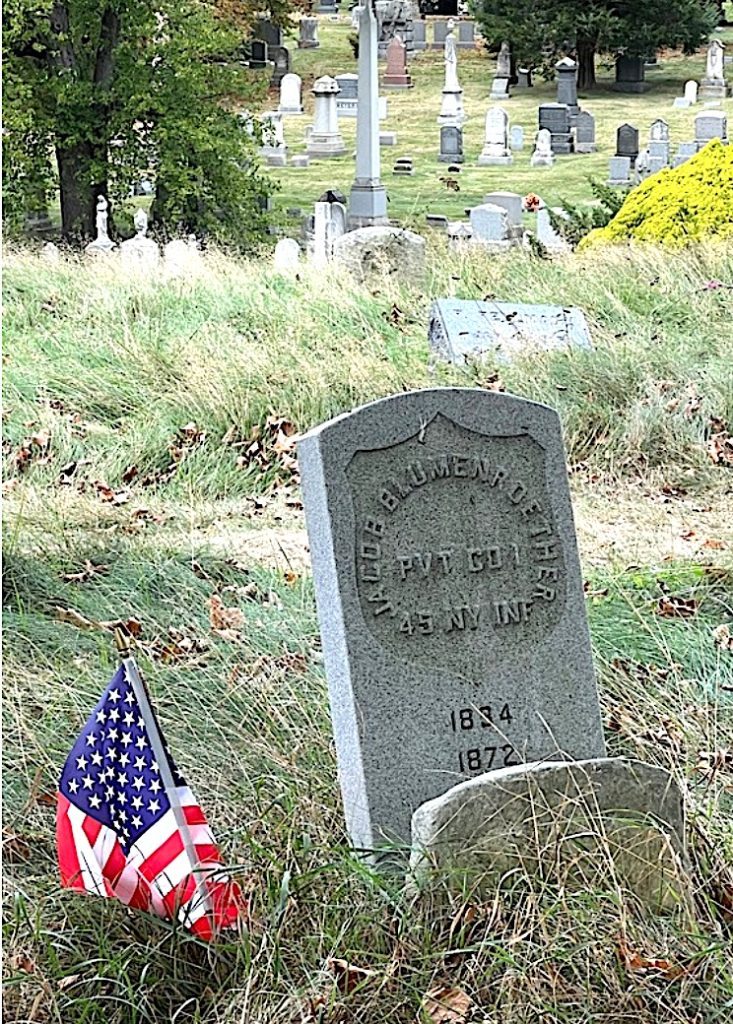
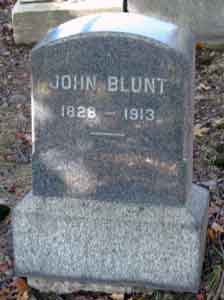
BLUNT, JOHN (1828-1913). Private, 8th New York Cavalry, Company B. Born in New Hampshire, he enlisted at New York City as a private on February 28, 1865, mustered into Company B of the 8th New York Cavalry the same day, and mustered out on June 27, 1865, at Alexandria, Virginia. He last resided at 463 8th Street, Brooklyn. Blunt died from pneumonia. Section 119, lot 157.
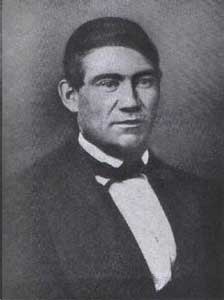
BLUNT, ORISON (1816-1879) Republican politician, firearms dealer and gunsmith. Born in Gardiner, Maine, Blunt went out to sea at the age of 14 and then settled in New York City where he was a firearms dealer with a shop, the Metropolitan Arms Company, on Broadway, with his partner, William Syms. He is listed as working in guns in the 1847 and 1851 New York City Directories at 44 Chatham and 177 Broadway. Their business flourished and they became prominent importers and dealers in fire-arms.
A wealthy industrialist, he was also interested in politics and was first elected alderman from the Third Ward in 1853. In the four years during which he served as alderman, he advocated for steam fire engines, the use of reflectors to light the piers, and fought against fat contracts, fraud and corruption in City government. He obtained a better and cheaper contract for concrete for street pavement. In 1857, he was elected to the Board of Supervisors and was re-elected to a six-year term in 1861.
A Union supporter, he was one of its major suppliers of rifles during the Civil War, helped raise many regiments, and gave liberally of his own funds. In support of the Union, he wrote a letter to Colonel John S. Loomis, an Illinois assistant adjutant general, to suggest that 4,000 British-made Enfield rifles, seized from captured Confederate blockade runners, be turned over to Union regiments in Illinois that badly needed weapons. On the back of the letter, President Abraham Lincoln endorsed Blunt’s plan subject to approval of the Secretary of War Edwin M. Stanton. The fate of the seized rifles was in the courts which suggested that they be sold at auction.
As per his obituaries in the New York Evening Post and The New York Times, he was a member of the County Substitute and Relief Committee. During the New York City Draft Riots in 1863, he worked with Boss Tweed, an opponent, and Mayor George Opdyke to establish a plan that would quell the disturbances. The Board of Supervisors, of which he was a member, appropriated $2,000,000, to fulfill New York’s draft quota by offering large bounties to recruits and substitutes; monies were dispensed from the committee’s rooms at 71 and 73 Duane Street. First convincing President Lincoln to suspend the draft temporarily, he then oversaw a fund that exempted firemen, police, militia and the needy from paying $300 for an exemption or substitute, paid bounties to draftees and settled claims for property damage.
Blunt also was an inventor who developed the pepper-box gun, a forerunner of the Gatling gun; one document referred to the gun as a coffee-mill gun. His gun, operated by a crank handle, shot off 70 rounds per minute. Reportedly tested by President Abraham Lincoln, it was sent to the front where it was captured by Confederates and later bought back by Blunt, who found it in a New York City junk shop and paid $5 for it. The New York Times reported that the aforementioned pepper-gun was kept at Blunt’s summer residence in Scarborough, Westchester County. Blunt also invented a breech-loading cannon, which he said embodied the same technology as the famed Krupp gun of Germany.
He was the Republican candidate for mayor of New York City in 1863. An undated article in the New York Sun, 1862-1864, notes that a mass meeting of the Citizens and Taxpayers of the City of New York was to be held in support of the his nomination for mayor. Another posting in support of Blunt’s candidacy for mayor, listed under Union Nomination for Mayor, in the New York Sun, the New York Tribune on November 26, 1863, and in The New York Times on November 28, 1863, reported on his aforementioned achievements as alderman and noted that he was liberal with his own money, balanced accounts to the penny, and never cheated others. Blunt lost the election to Democrat C. G. Gunther.
On May 11, 1869, the New York Herald listed Blunt among the “Solid Men” of New York City who had incomes over $10,000; he earned $21,953 in 1867 and $16,962 in 1868. A member of the Union League Club and the New-York Historical Society, he last lived at 55 East 53rd Street in Manhattan. His obituary noted that he succumbed to dropsy (edema) and a large tumor in his chest that displaced his heart. The New York Times reported that he retired about fifteen years before his death and lived off his ample fortune. He was survived by his widow and five children.
An article in The New York Times about his funeral on April 25, 1879, noted that his body was exposed to view by friends, family, business acquaintances and former political associates. Floral tributes surrounded his casket and a service of the Protestant Episcopal Church was read but there was no sermon. Carriages followed the hearse for burial at Green-Wood. Section 36, lot 11464.

BOARDMAN, CHARLES HODGE (1838-1907). Acting assistant surgeon, United States Army. Originally from Philadelphia, Pennsylvania, Boardman studied both medicine and law beginning his undergraduate education at Yale College. He was awarded a degree from the University of Pennsylvania where he was active in fraternal organizations but his name is also listed among those of the class of 1859 from Yale. After receiving his medical degree in 1862 from the University of Pennsylvania, he enlisted as an acting assistant surgeon in the United States Army, served three years, and was discharged in 1865.
After the War, Boardman practiced medicine in Philadelphia. He is listed as a physician in the Philadelphia Directories for 1865, 1866 and 1867. Subsequently, he moved to St. Paul, Minnesota, in 1869 where he became a prominent physician and was active in civic affairs. He served there as the State Commissioner in Lunacy from 1879-1883, a position instituted to address mental health issues. Boardman was a member of the State Board of Medical Examiners, president of the City Board of Water Commissioners, director of the Public Library, secretary of the State Medical Society, and medical director of the Northern Pacific Railroad (1887-1890). He was also a professor of medical jurisprudence at the University of Minnesota from 1887-1890, and a life member of the Minnesota Historical Society. At the time of his passport application in 1890, he was 6′ tall with blue-grey eyes, dark brown hair, beard and moustache and an oval face. He moved to Brooklyn in 1900. He last lived at 354 47th Street in Brooklyn. His death was attributed to heart disease. Section 200, lot 24559, grave 6.
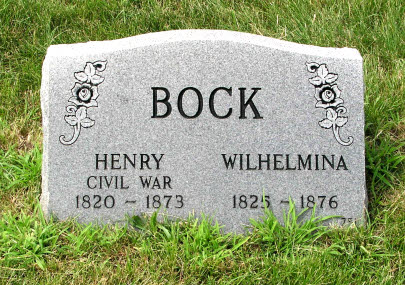
BOCK (or BOCH), HENRY (1820-1873). Private, 83rd New York, Company L. Born in Hanover, Germany, nee Johann Heinrich Bock, he had hazel eyes, light hair and was a laborer. He immigrated to the United States in 1854. Bock was drafted in the 4th Congressional District of New York City on August 24, 1863, and mustered into the 83rd New York. He had Bright’s disease, performed no active duty, and was discharged for disability at New York City on May 27, 1864.
Bock became a naturalized citizen on September 20, 1864. The 1870 census listed the value of his personal effects at $200. His last residence was in New York City. He died from edema of the lungs at Roosevelt Hospital in Manhattan. Wilhelmina Bock, who is interred with him, applied for and received a widow’s pension, certificate 317,516. The family name was later changed to “Buck.” Section 17, lot 17245, grave 751.
BODDELY, WILLIAM C. (1842-1882). Private, 143rd New York Infantry, Company E. A native of England, he enlisted on August 16, 1862, at Wurtsboro, New York, and mustered into the 143rd New York on October 8 of that year. He deserted the next day at Monticello, New York. He last resided at the House of Rest in New York City where he succumbed to tuberculosis. Section 115, lot 4196, grave 397.
BODDY, RICHARD (1815-1875). Corporal, 10th New York Infantry, Company D. Born in England, he was a clerk in 1850. Boddy enlisted at New York City as a private on April 26, 1861, and mustered into the 10th New York four days later. He was promoted to corporal on November 4 and was discharged for disability on March 14, 1863, at York, Pennsylvania. He last lived at 336 West 11th Street in Manhattan. His death was attributed to tuberculosis. Elizabeth Boddy, who is interred with him, applied for and was granted a widow’s pension in 1879, certificate 191,170. Section 58, lot 3806.

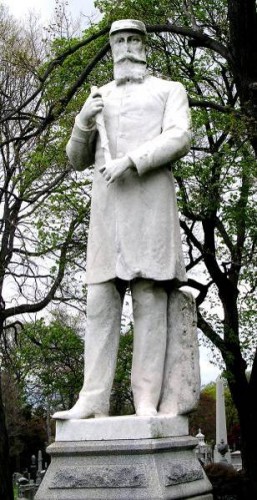
BODENHAUSEN, LOUIS (1825-1869). Drum major and sergeant, 158th New York Infantry, Company E. Bodenhausen, who was born in Saxony, Germany, was a skate-maker by trade according to the 1860 census. He enlisted as a corporal on August 8, 1862, mustered into his company on August 31, was promoted to sergeant on March 1, 1865, and mustered out on June 30, 1865, at Richmond, Virginia. Bodenhausen died from heart disease. He last lived at 26 Myrtle Avenue in Brooklyn. Sophia Bodenhausen, who is interred with him, applied for and received a widow’s pension in 1880, certificate 254,015. Section 137, lot 28101, graves 2 and 3.
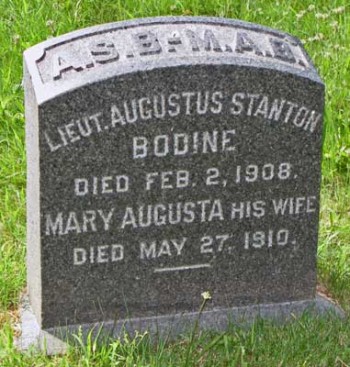
BODINE, AUGUSTUS STANTON (1834-1908). First lieutenant, 127th New York Infantry, Companies B and C; corporal, 71st Regiment, New York State Militia, Company D. He is likely the Augustus Bodine who is listed as a clerk in the Brooklyn Directory for 1857-1862. On April 19, 1861, he enrolled in the 71st New York State Militia at New York City, and mustered in on May 3 as a private in Company D. On July 30, 1861, he mustered out with his company at New York City with the rank of corporal. He enlisted again at New York City on August 15, 1862, as a first sergeant, and mustered into Company B of the 127th New York Infantry on September 8. He was promoted to second lieutenant of Company C on November 26, 1862, and to first lieutenant on April 15, 1864. Describing the Battle of Honey Hill, South Carolina, he wrote a narrative noting the fighting conditions, the blunders made by the troops, and the grisly sight of the wounded. He mustered out at Charleston, South Carolina, on June 30, 1865.
In civilian life, Bodine earned a living as a stationer. As per the 1870-1873 New York City Directory, he was a stationer at 247 Pearl Street who lived at 458 Pacific Street in Brooklyn. The 1876-1878 New York City Directory and a separate 1877 New York City Directory list him as a stationer at 60 Beekman Street; he then lived at 678 Classon Avenue in Brooklyn. He applied for and received an invalid pension in 1891, certificate 734,806, and his wife, Mary A. Bodine, received a widow’s pension in 1908, certificate 670,464. His last residence was in Bridgeport, Connecticut. Bodine’s cause of death was chronic interstitial nephritis. Section 154, lot 22815.
BODLE (or BOODLE), SAMUEL (1820-1889). Private, 67th New York Infantry, Company I; 5th New York Heavy Artillery, Company B. A native of Ireland, he enlisted at the age of 41, at Brooklyn, on June 3 1861. After mustering into Company I of the 67th Infantry on June 20, he was discharged for disability four days later at South Brothers Island in New York Harbor. He re-enlisted as a private on April 4, 1862, and immediately mustered into Company B of the 5th Heavy Artillery. On May 4, 1864, he re-enlisted for another year and mustered out May 12, 1865, at Harpers Ferry, West Virginia.
Bodle is listed as being in the United States Army in the 1865 Brooklyn Directory; he then lived at 25 Classon Avenue. As per the 1866 Brooklyn Directory, he was employed as a clerk and still lived at the same Classon Avenue address. The 1870 and 1880 censuses listed him as a laborer. According to the Brooklyn Directory for 1880-1882, he worked in leathers and lived at 123 Classon Avenue. Bodle’s last lived at 123 Classon Avenue in Brooklyn. He died from pneumonia. His military service is confirmed by the 1890 Veterans Schedule. Section 192, lot 27682.
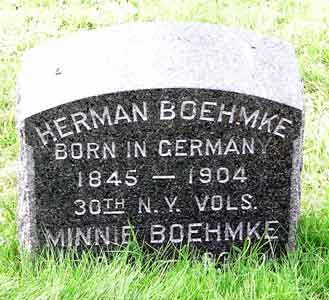
BOEHMKE, HEINRICH (or HERMAN) (enlisted as SMITH, CHARLES) (1845-1904). Private, 30th Independent Battery, New York Light Artillery; 11th Connecticut Infantry, Company F. Of German origin, he enlisted on July 24, 1861, at New York City, mustered into the 30th Light Artillery on August 19, and was discharged at New York City on August 19, 1864. A resident of Orange, Connecticut, he enlisted as a private under the alias Charles Smith on November 14, 1864, mustered into the 11th Connecticut, and was discharged on May 15, 1865.
According to the census for 1880, Boehmke was a carpenter by trade. The 1890 Veterans Schedule confirms his military service. His application for an invalid pension was approved in 1890, certificate 658,604. As per the Brooklyn Directory for 1892-1894, he worked in the cigar business and lived at 205 21st Street.He last lived at 205 21st Street in Brooklyn. A government-issued headstone for Union veterans was ordered and placed on his grave shortly after his death. Wilhelmine Boehmke applied for and received a widow’s pension in 1904, certificate 583,576. Section 30, lot 35223.
BOESEN, FREDERICK (1835-1913). Sergeant, 23rd Regiment, New York State National Guard, Company C. Boesen, a native of Copenhagen, Denmark, settled with his family in Brooklyn at the age of twelve. During the Civil War, he served with Company C of the 23rd Regiment for 30 days in 1863.
The yearly Brooklyn Directories for 1863 through 1867 list him as a clerk/bookkeeper who lived at 372 Carlton Avenue. As per his obituary in the Brooklyn Standard Union, which confirms his Civil War service, Boesen was employed as a clerk for fifteen years by the Title Guarantee and Trust Company. In addition, he was a member of the Union League, the Hamilton Club and attended the Nostrand Avenue Methodist Episcopal Church. He last lived at 1101 Park Place, Brooklyn. Boesen’s cause of death was arteriosclerosis. He was survived by his widow, Adelaide, and a married daughter. Section 167, lot 17696. grave 5.